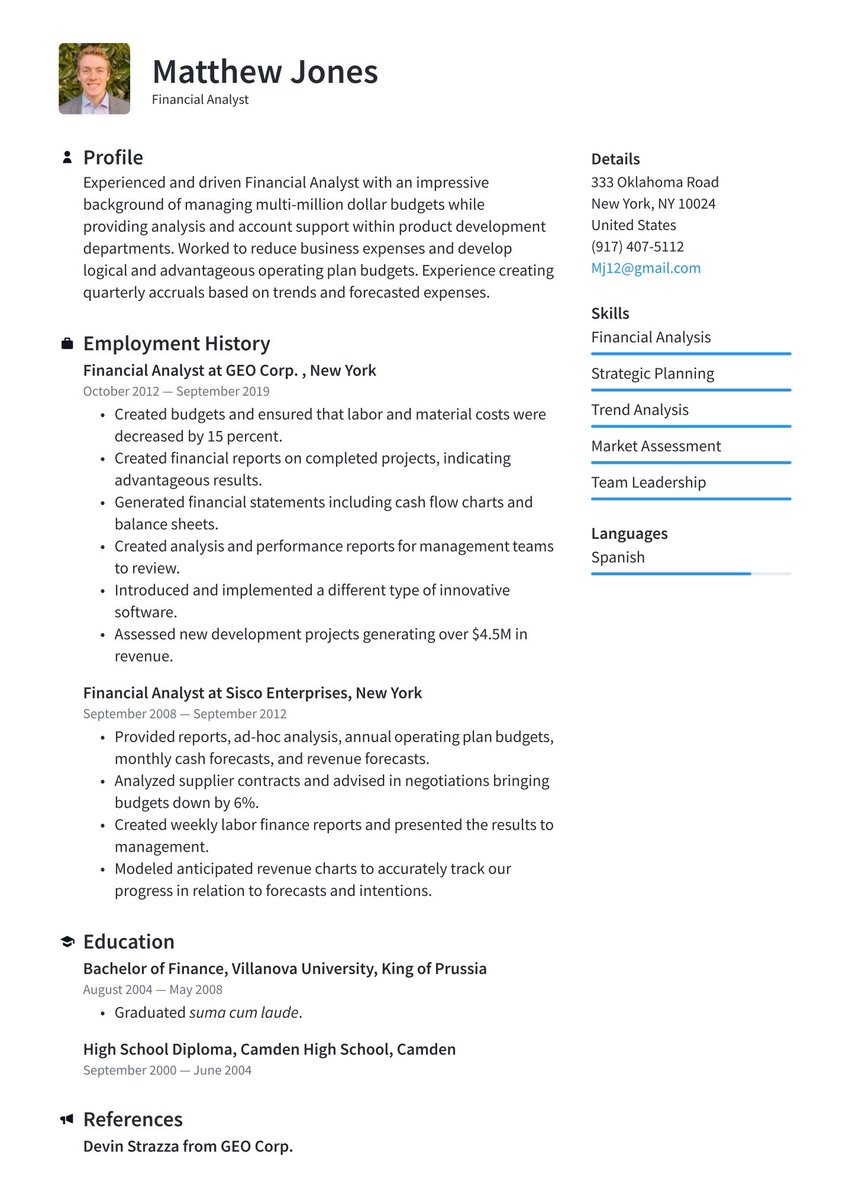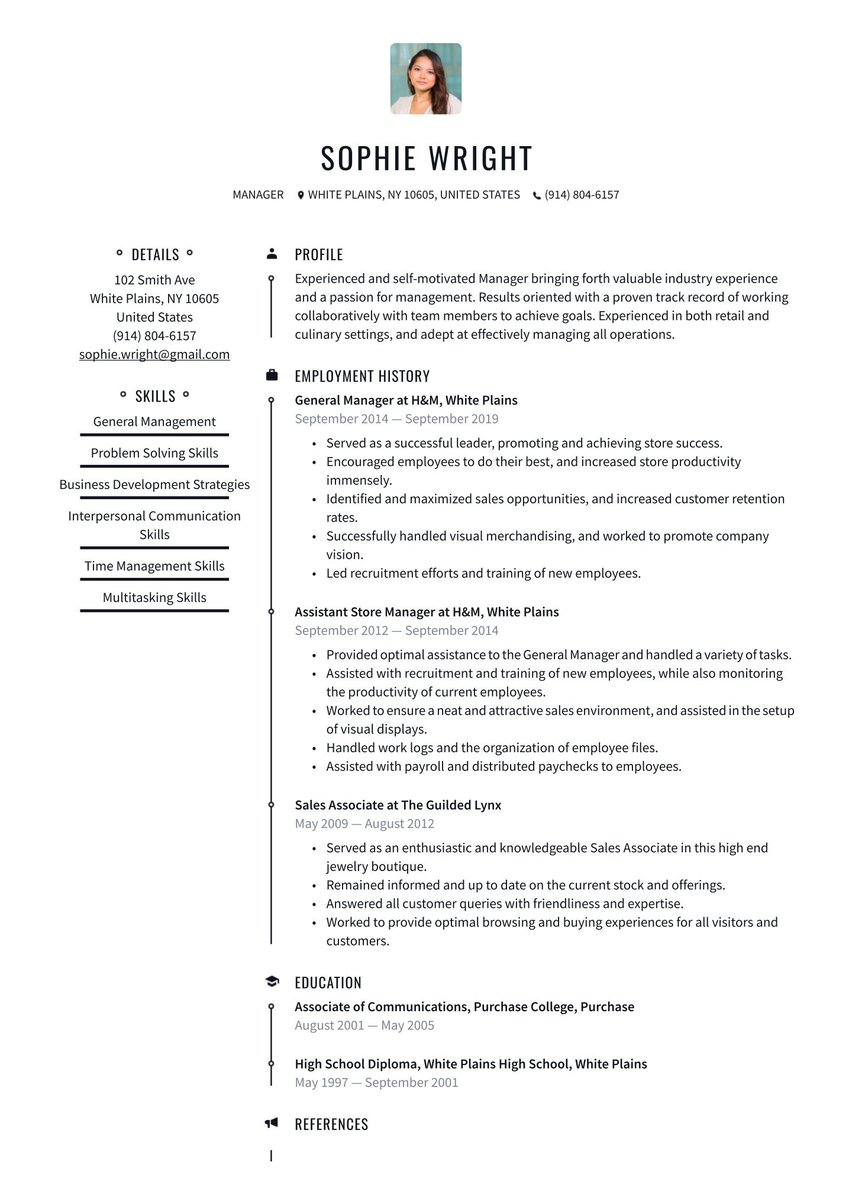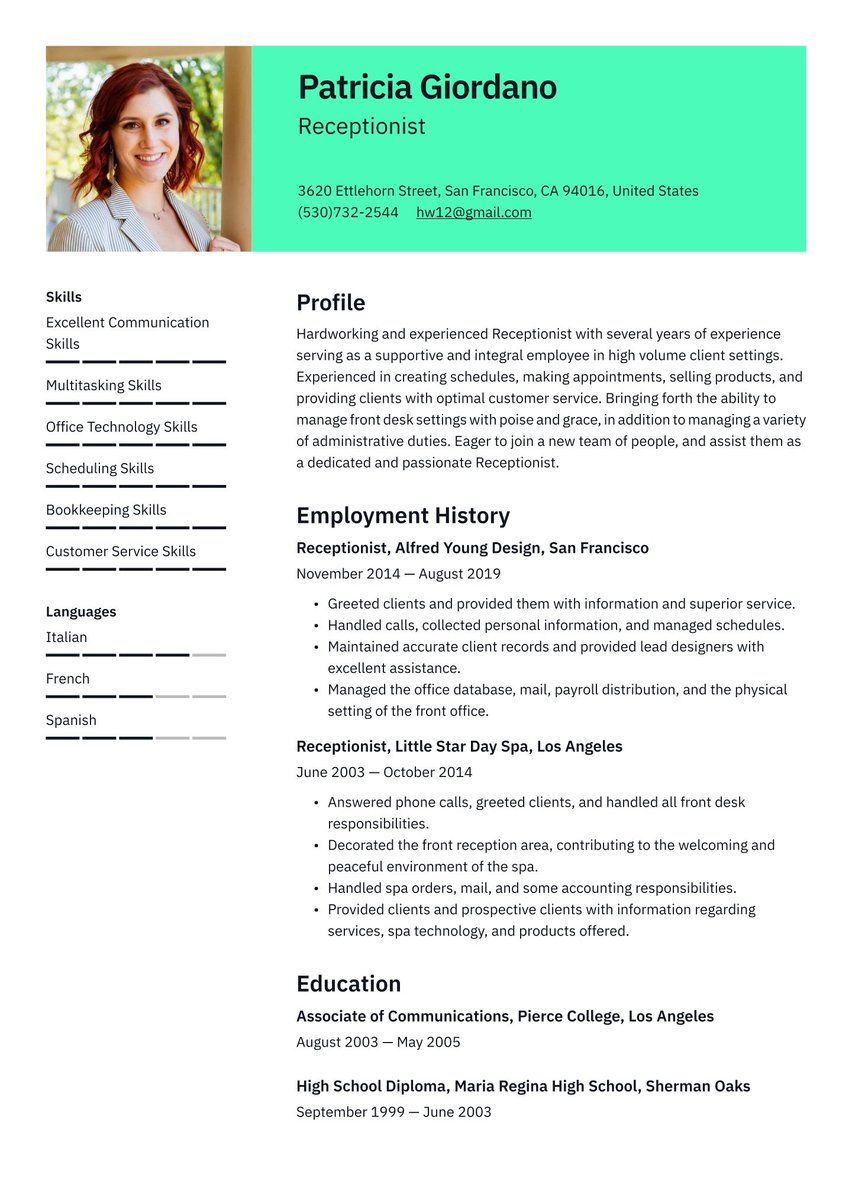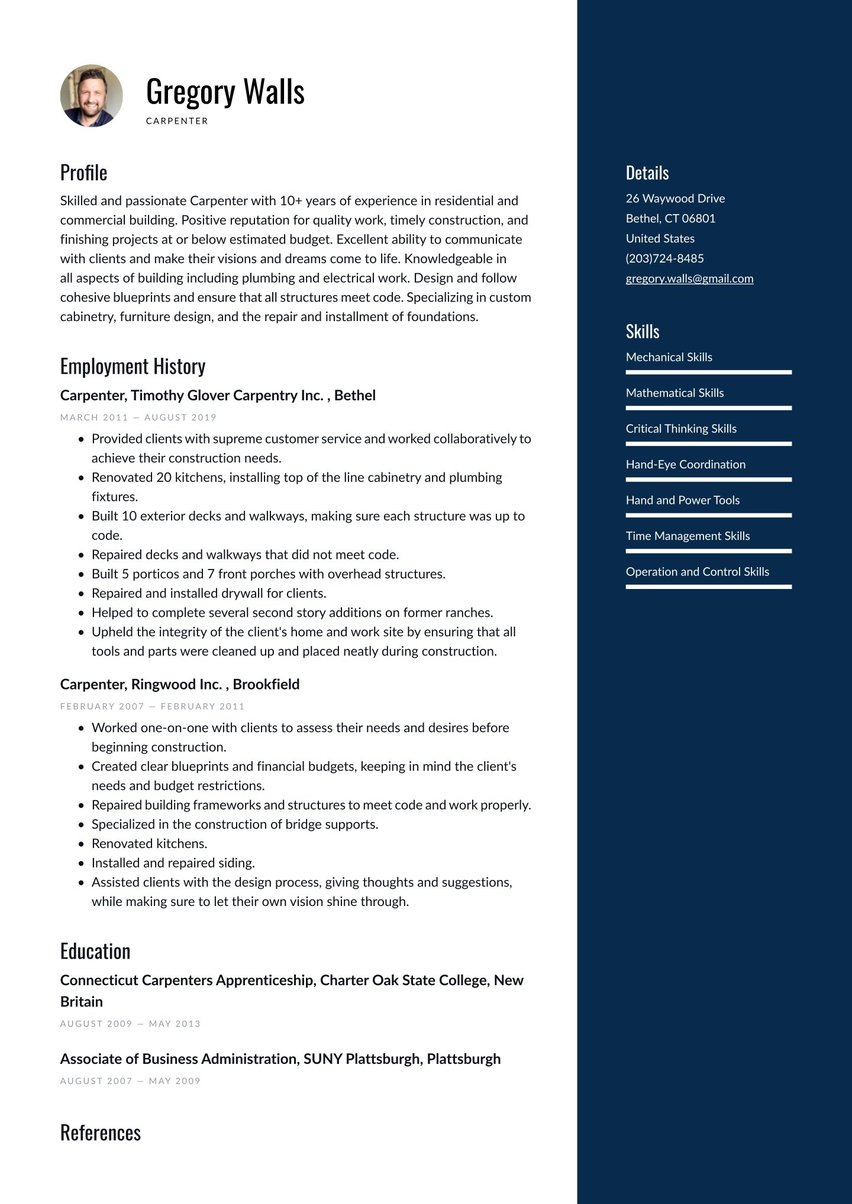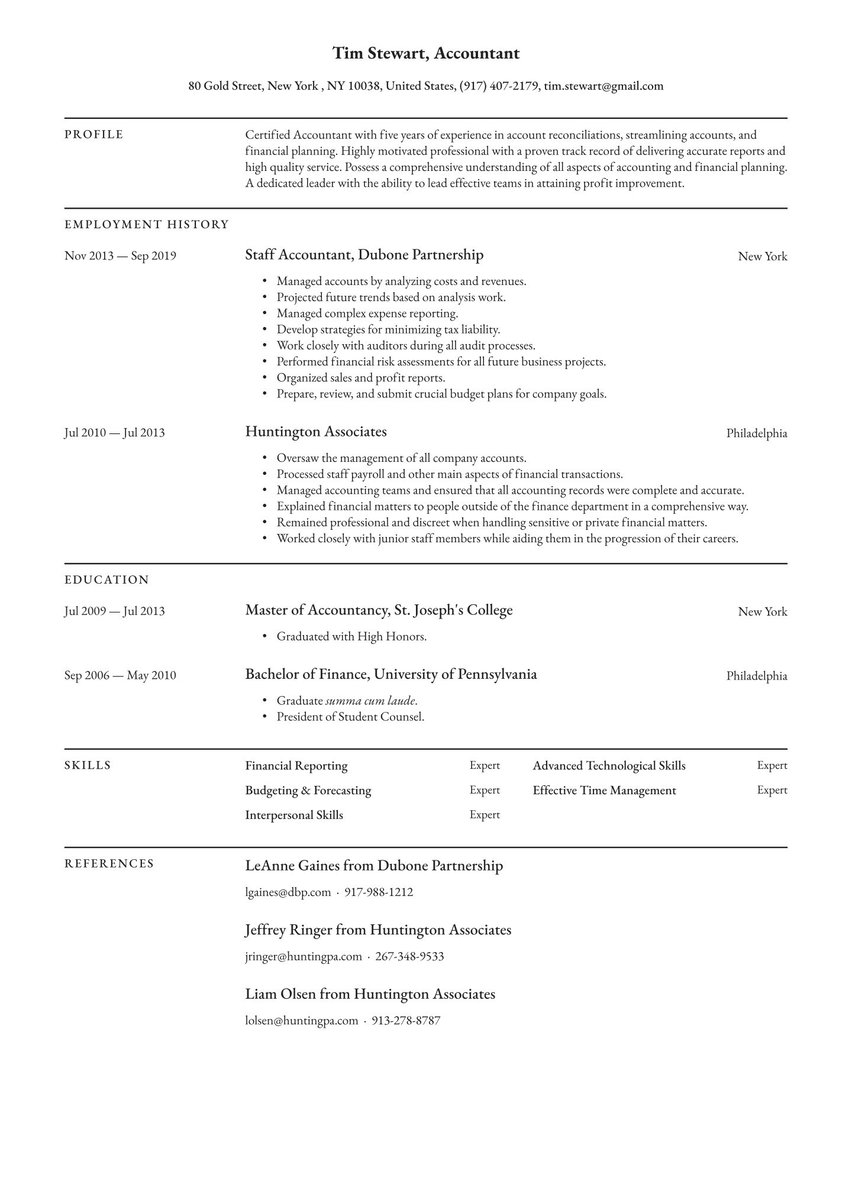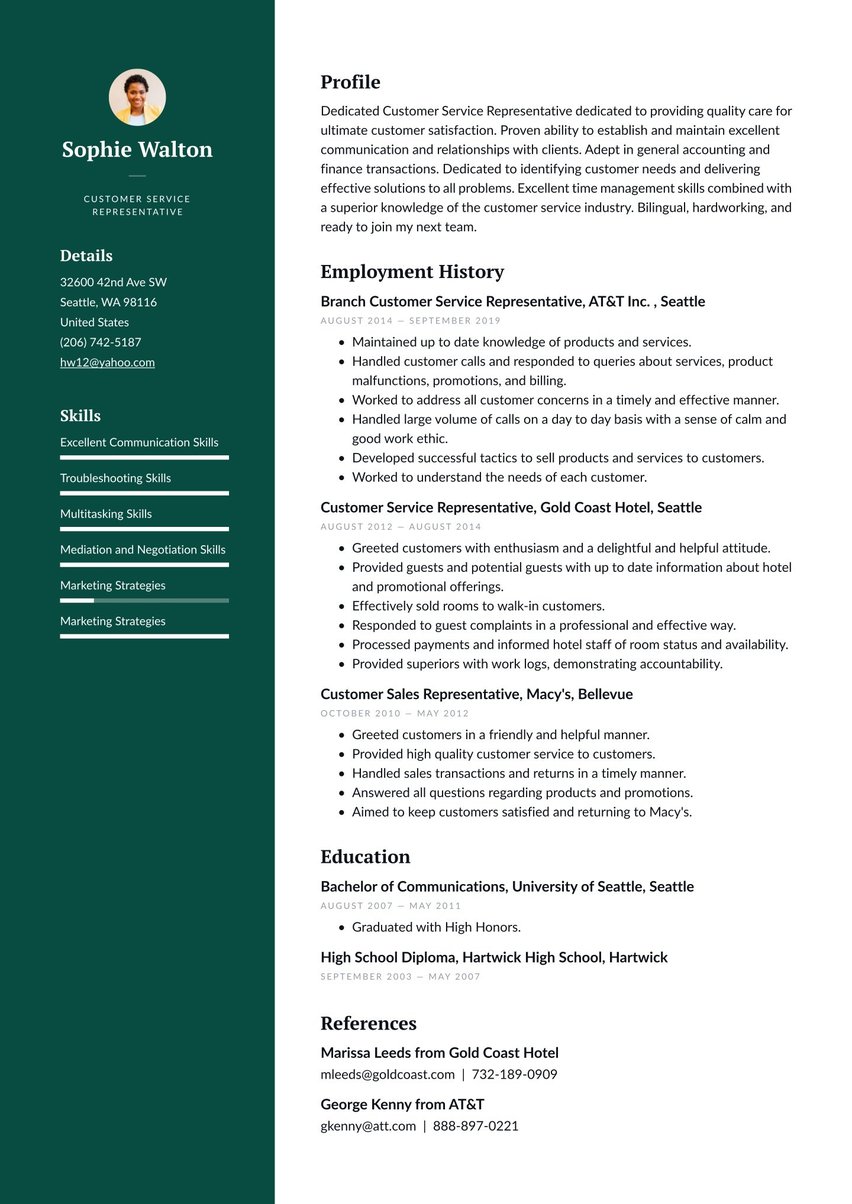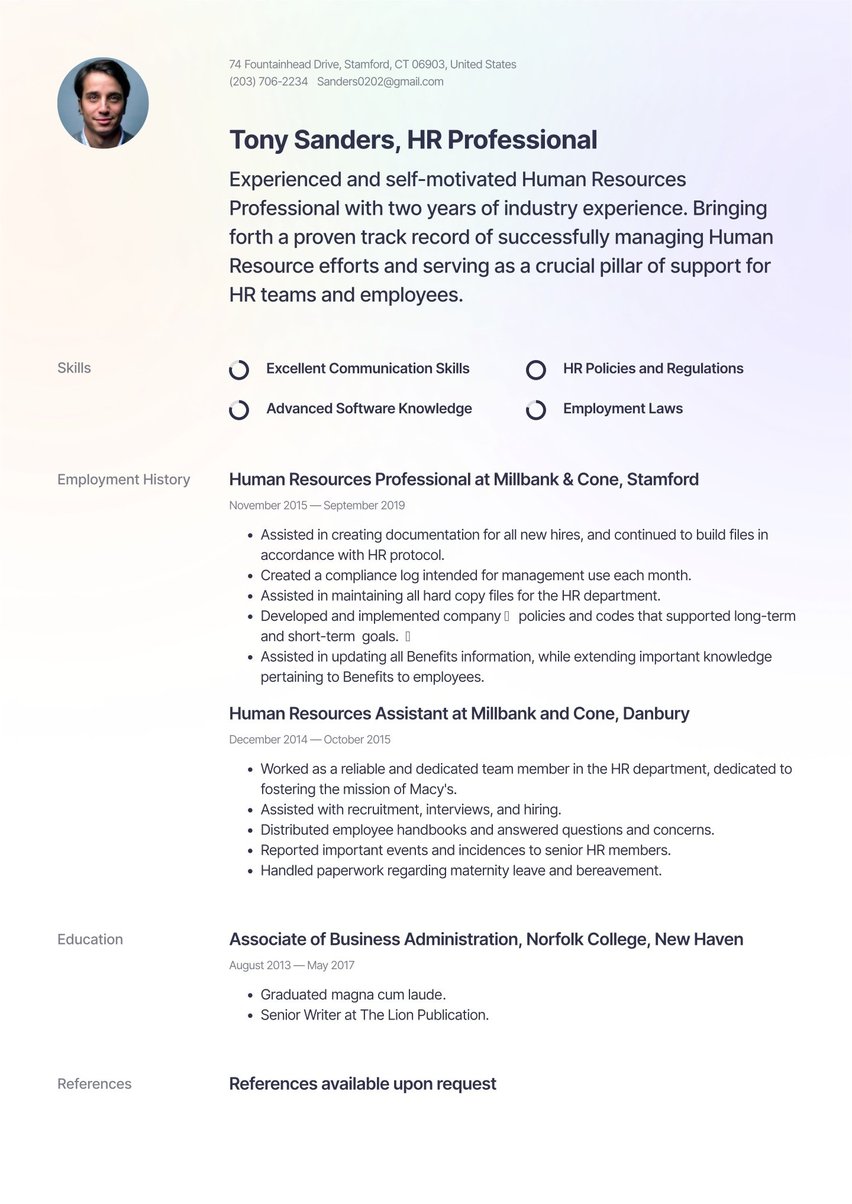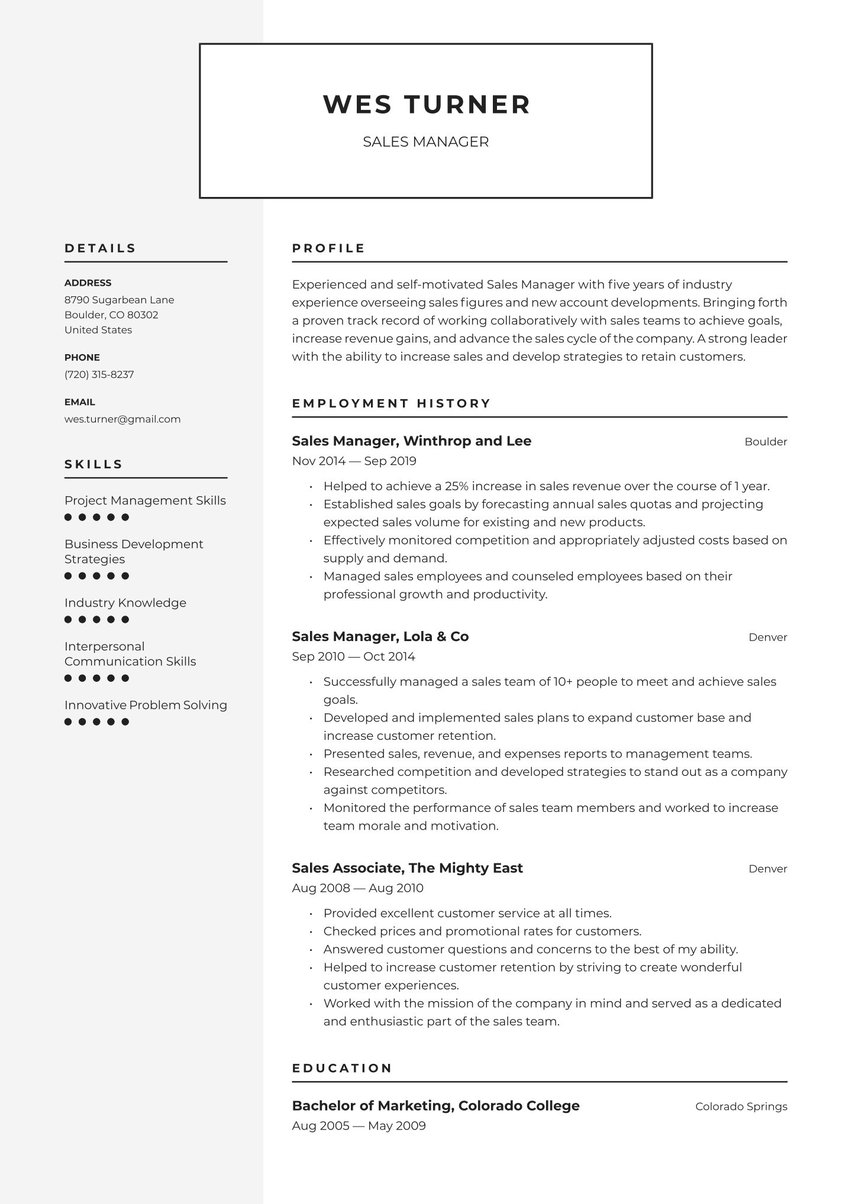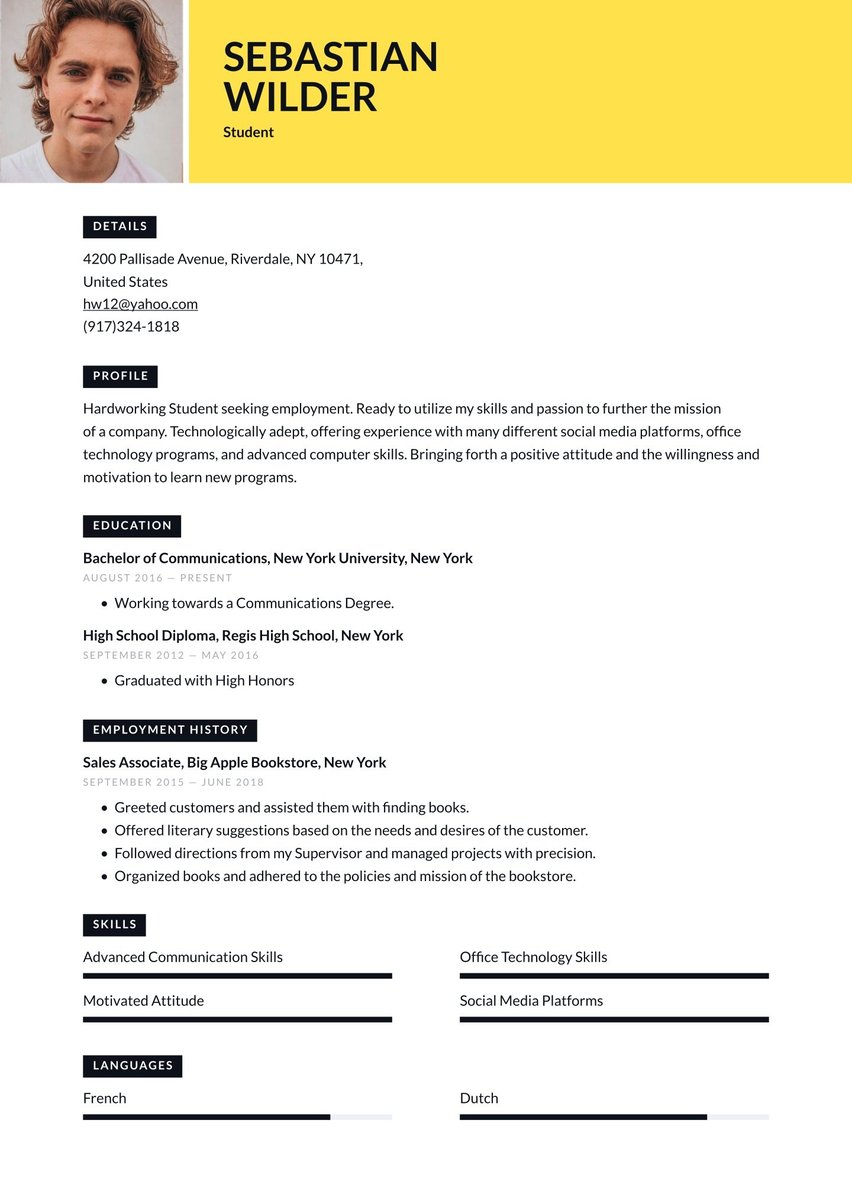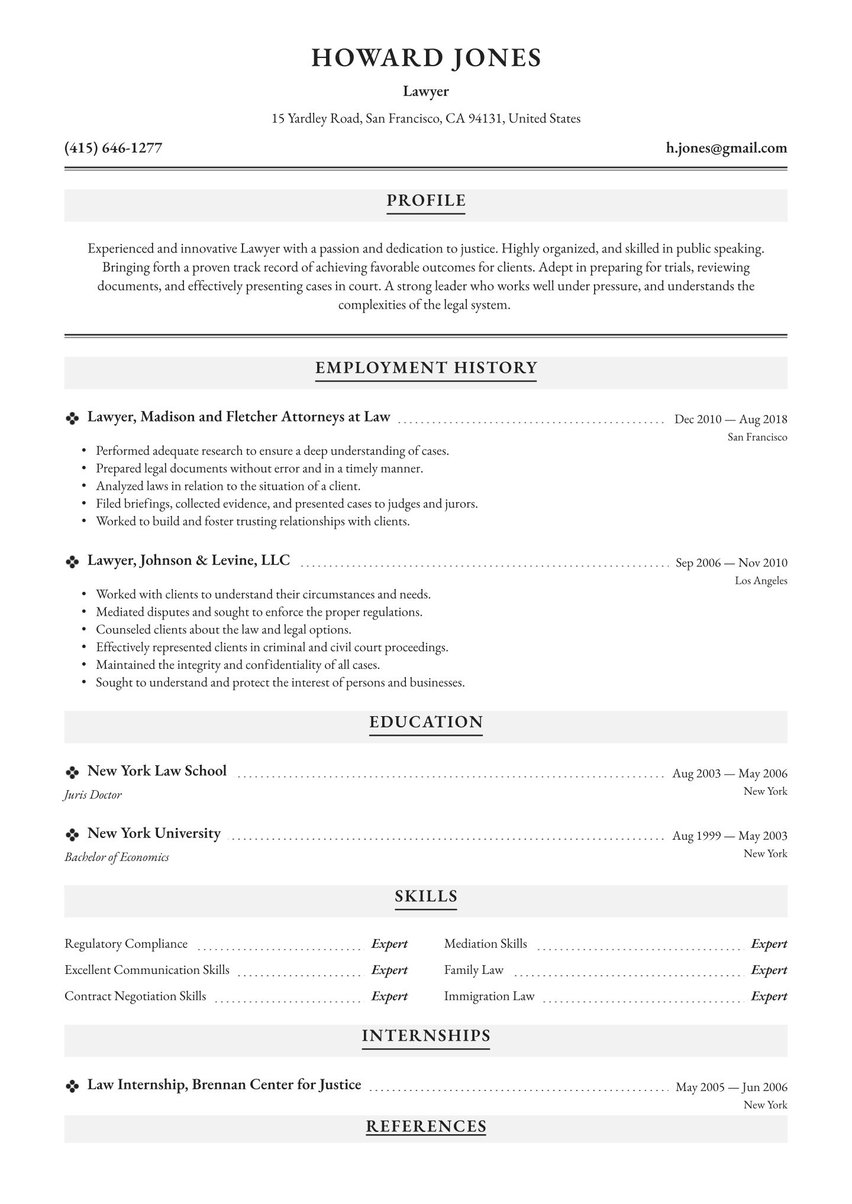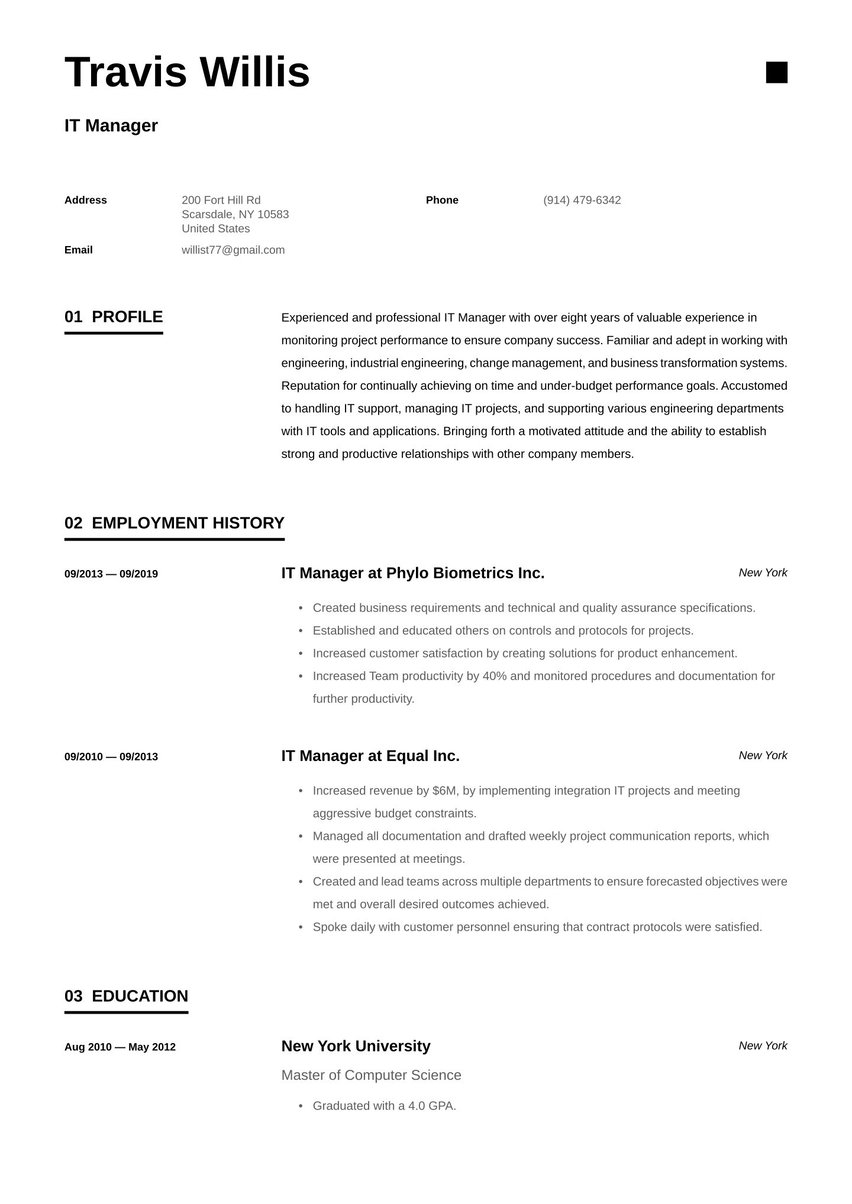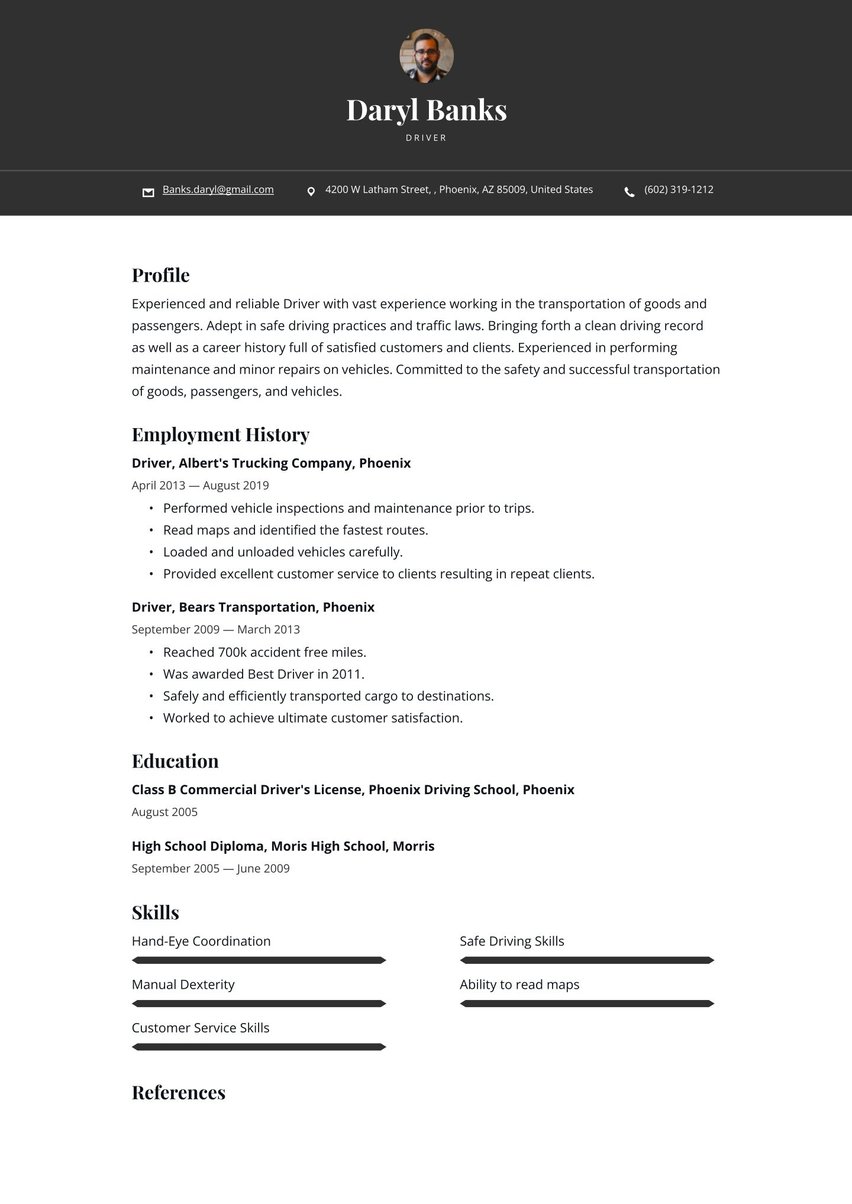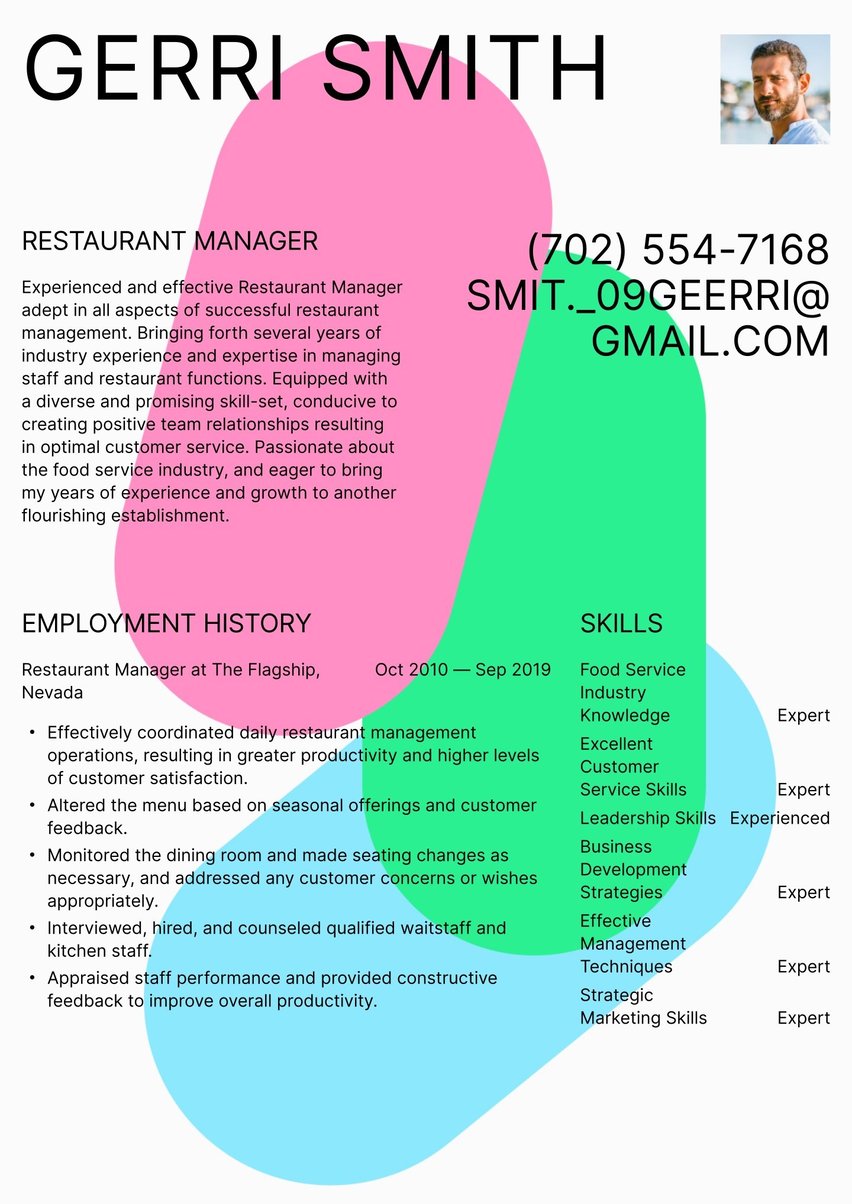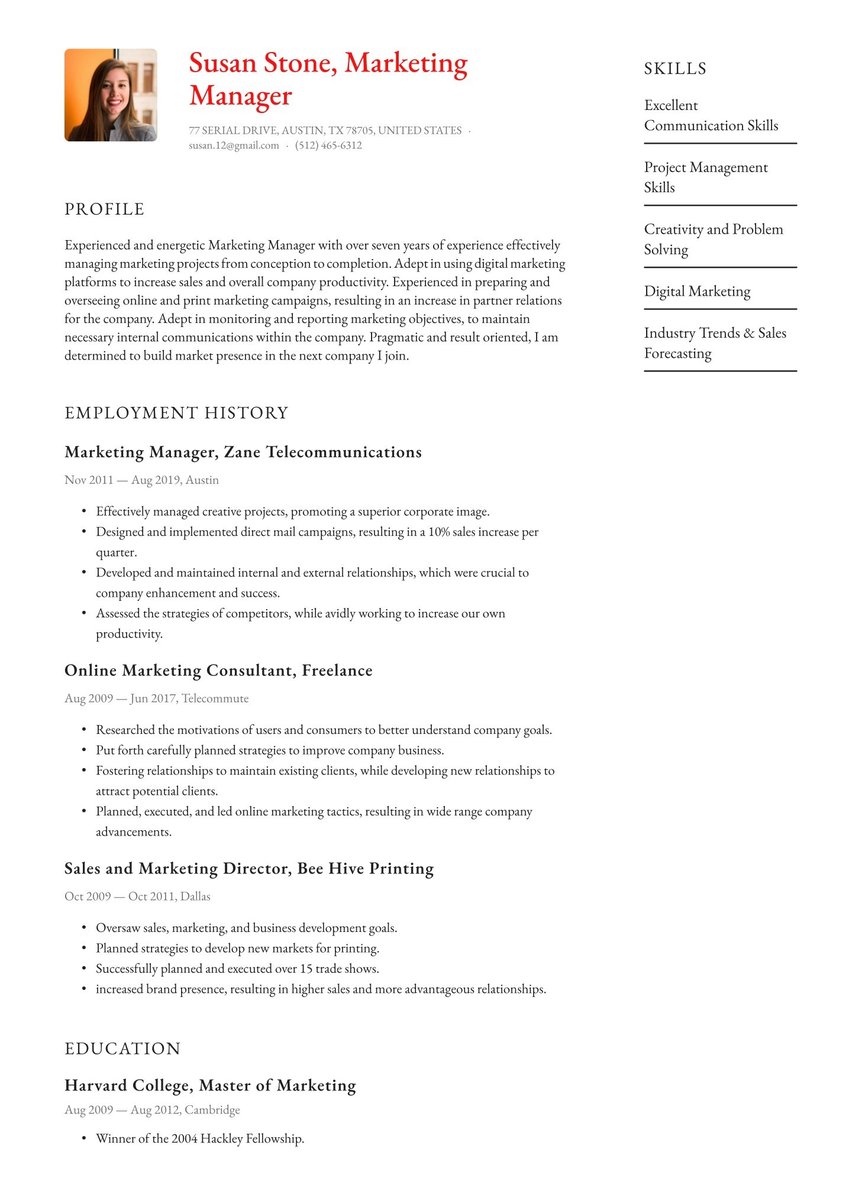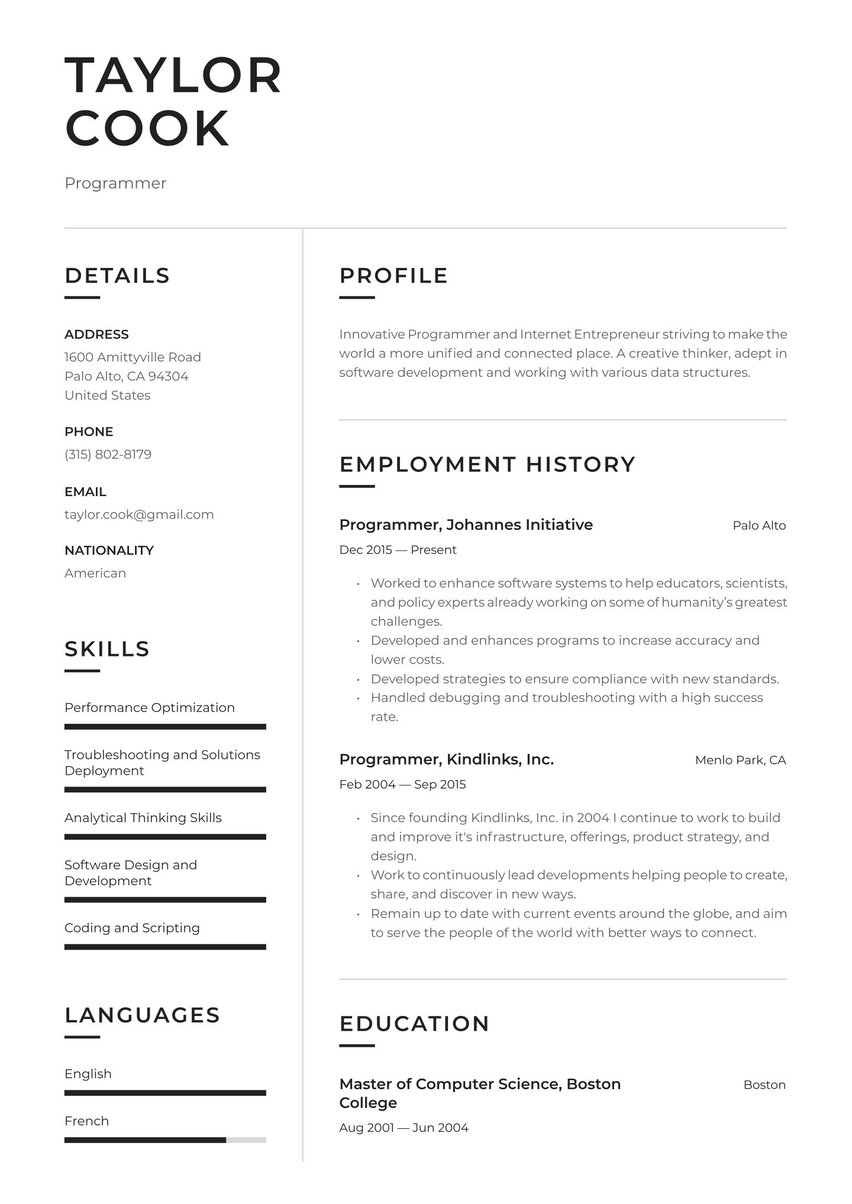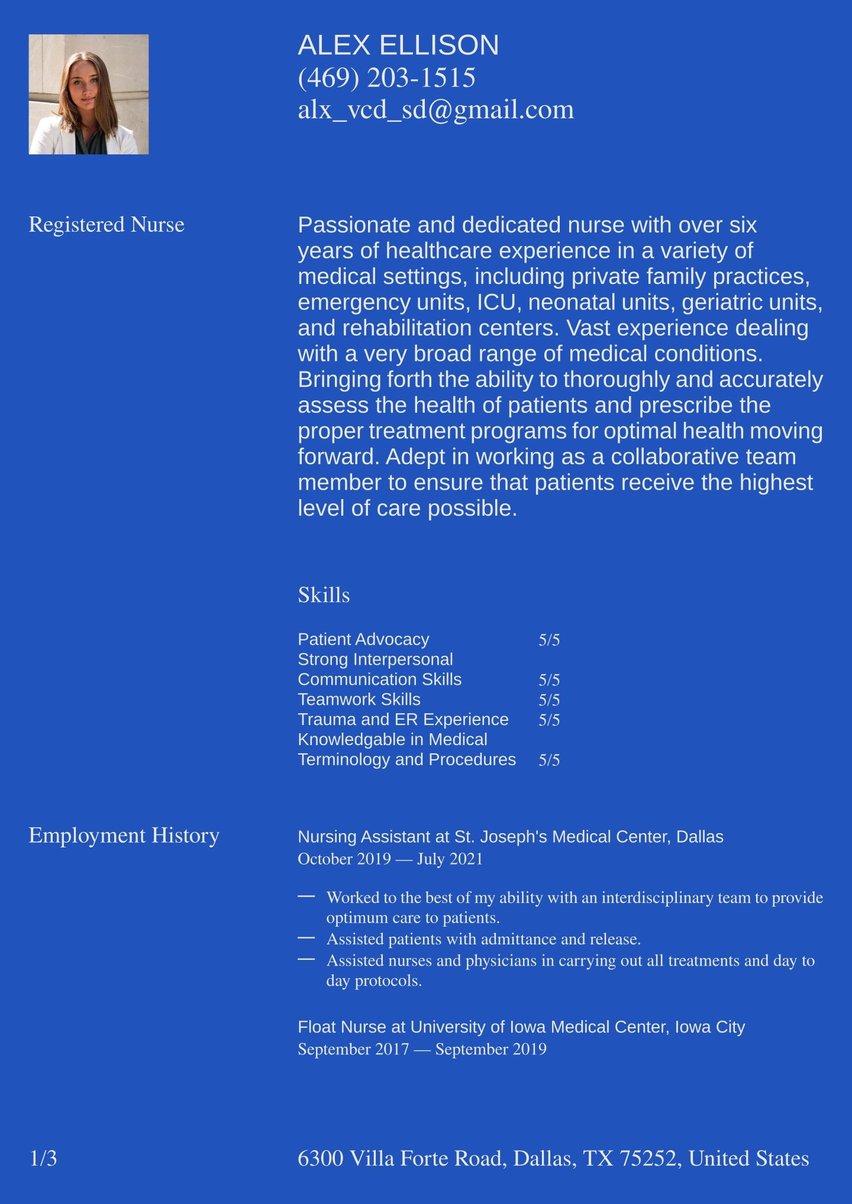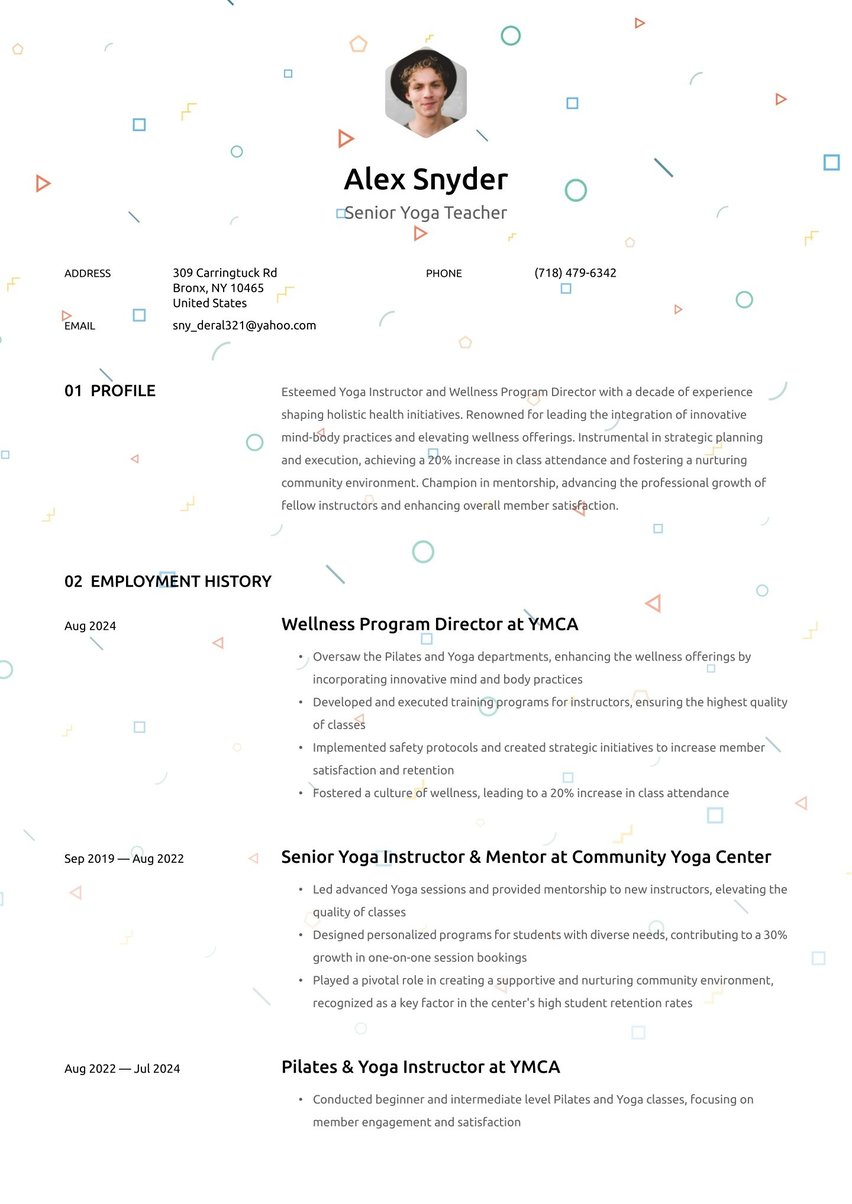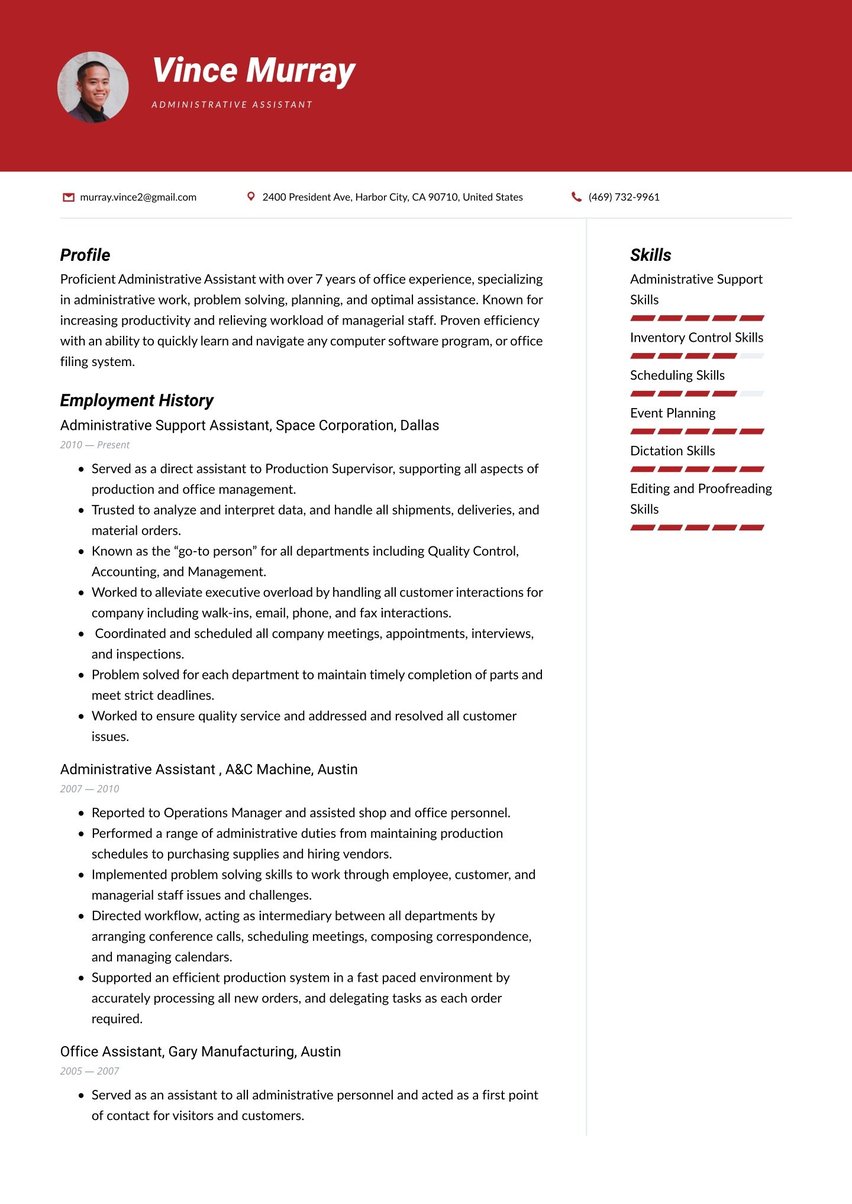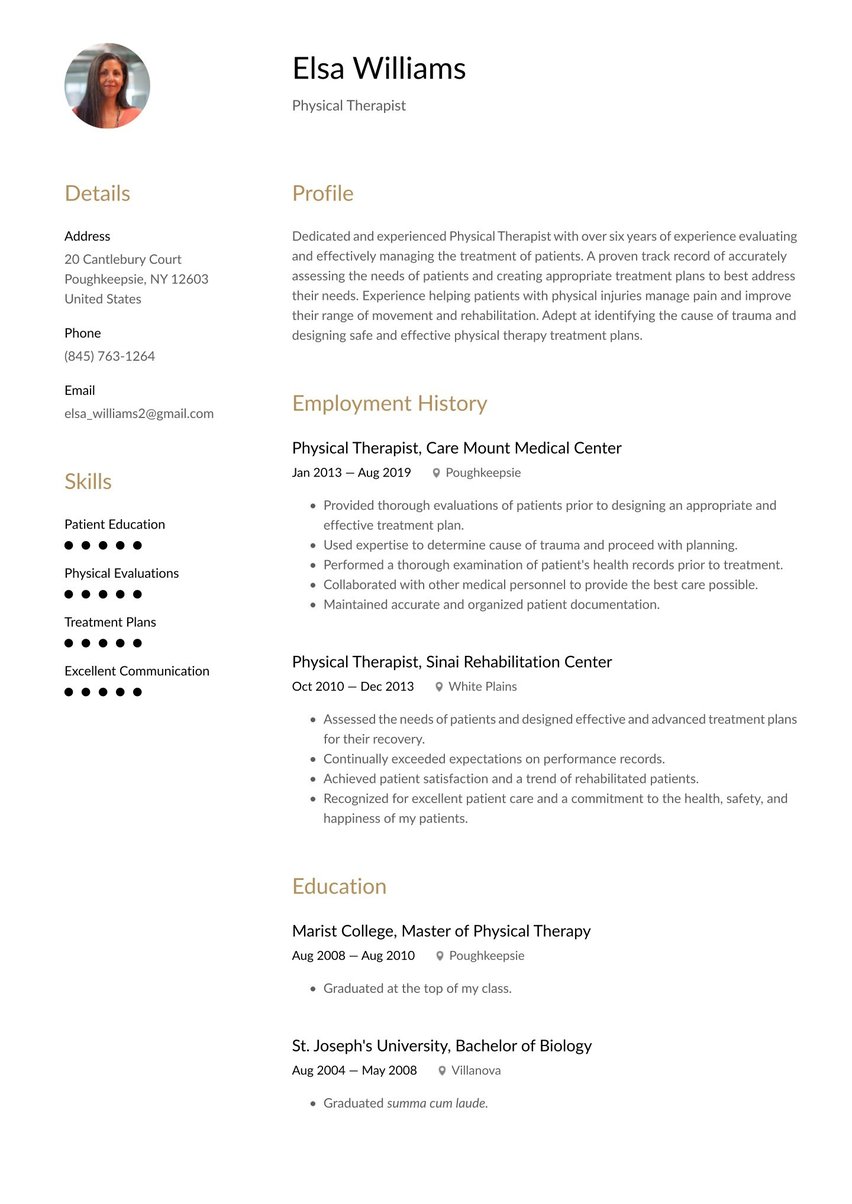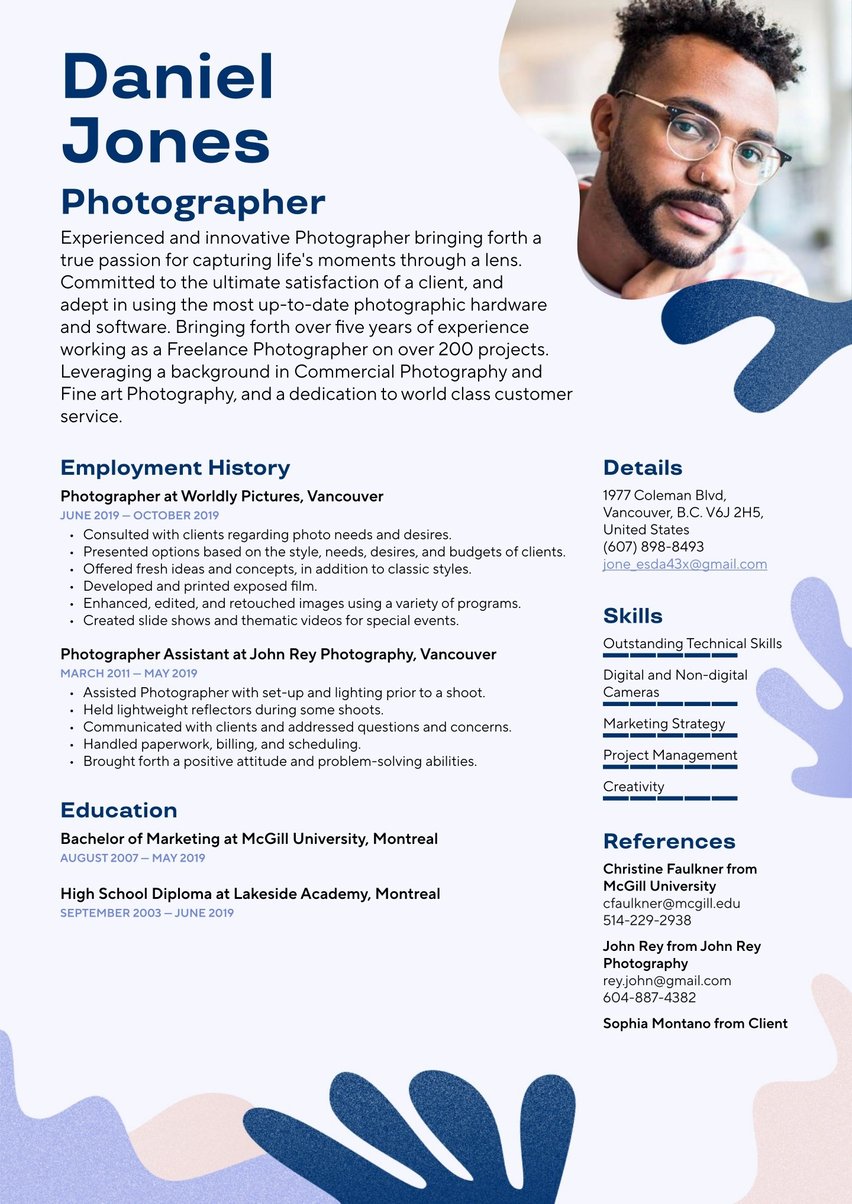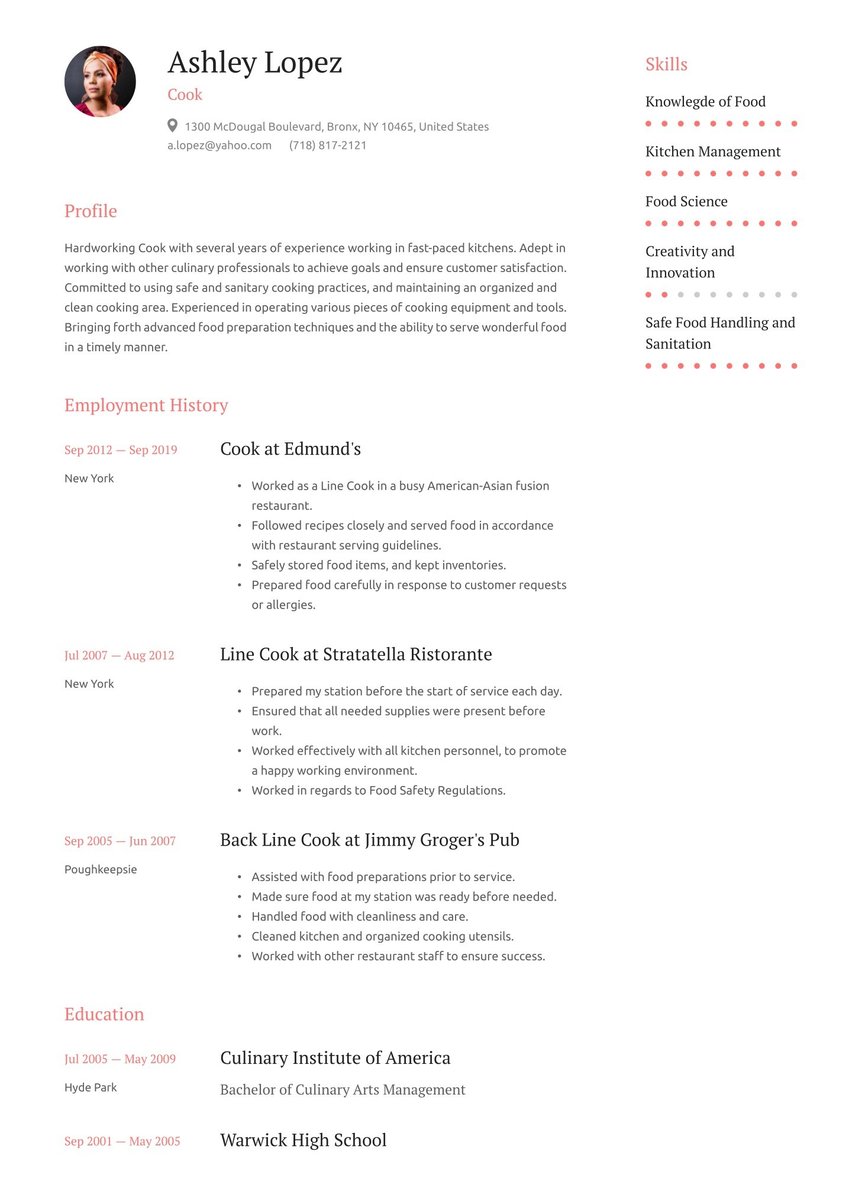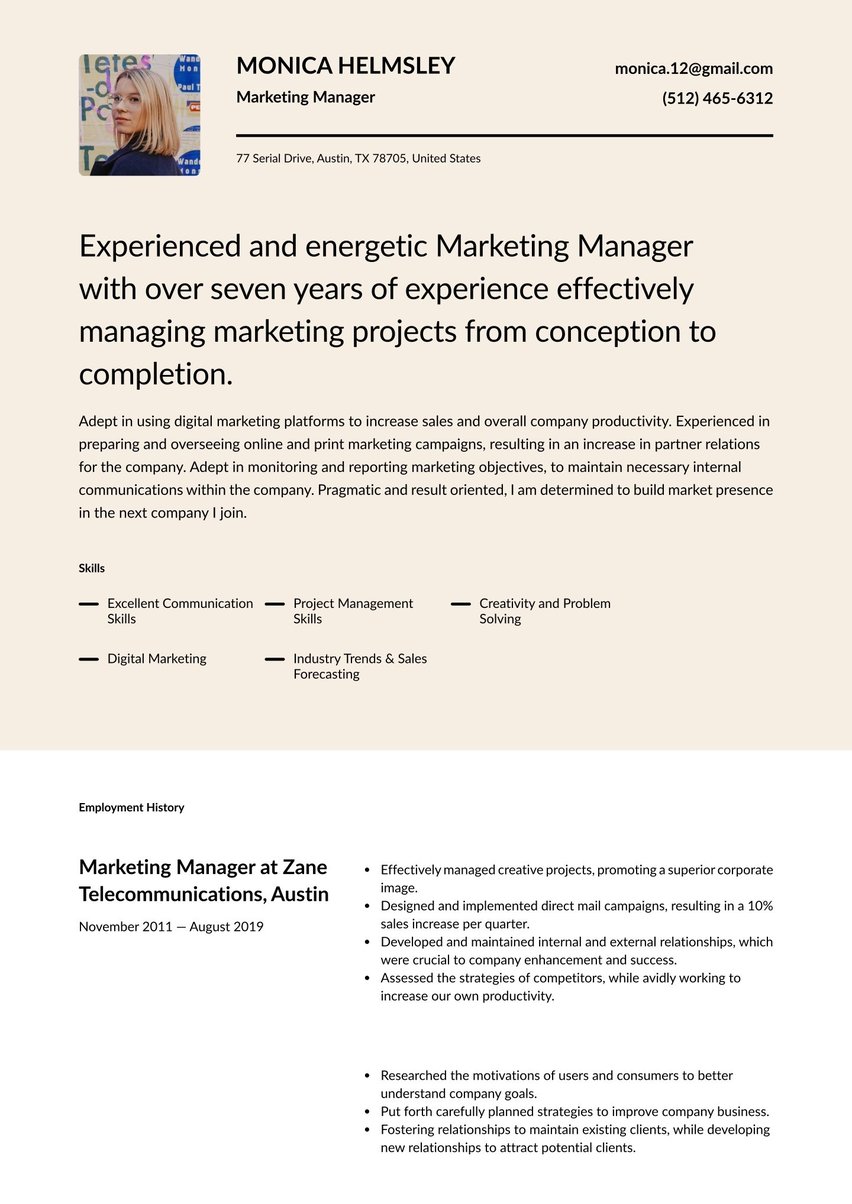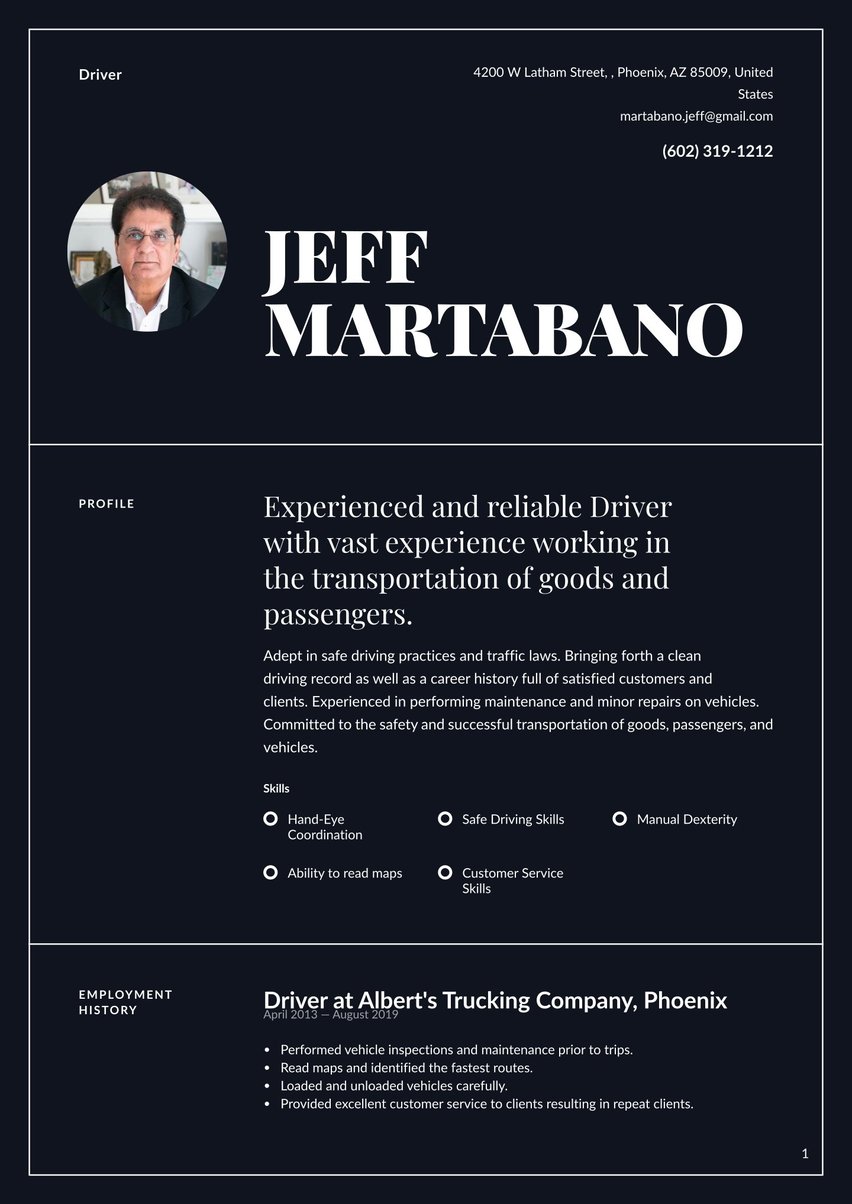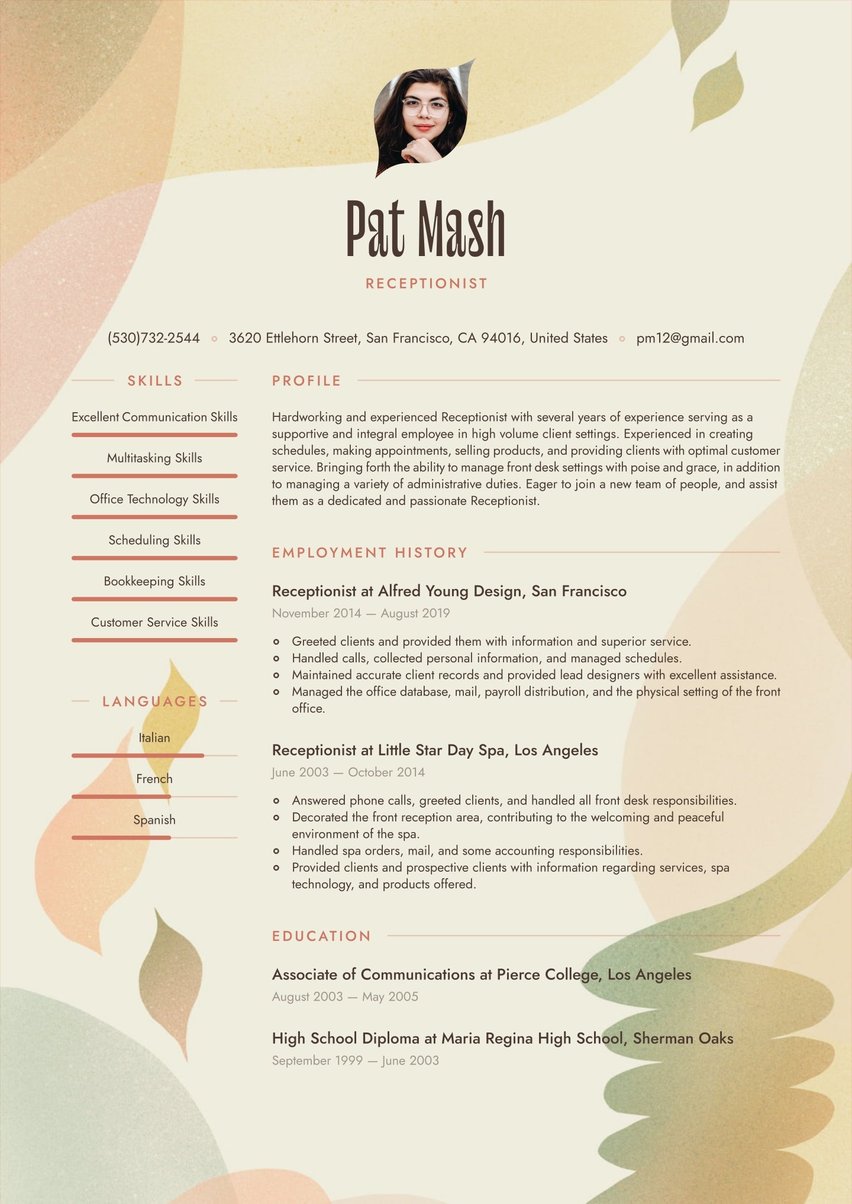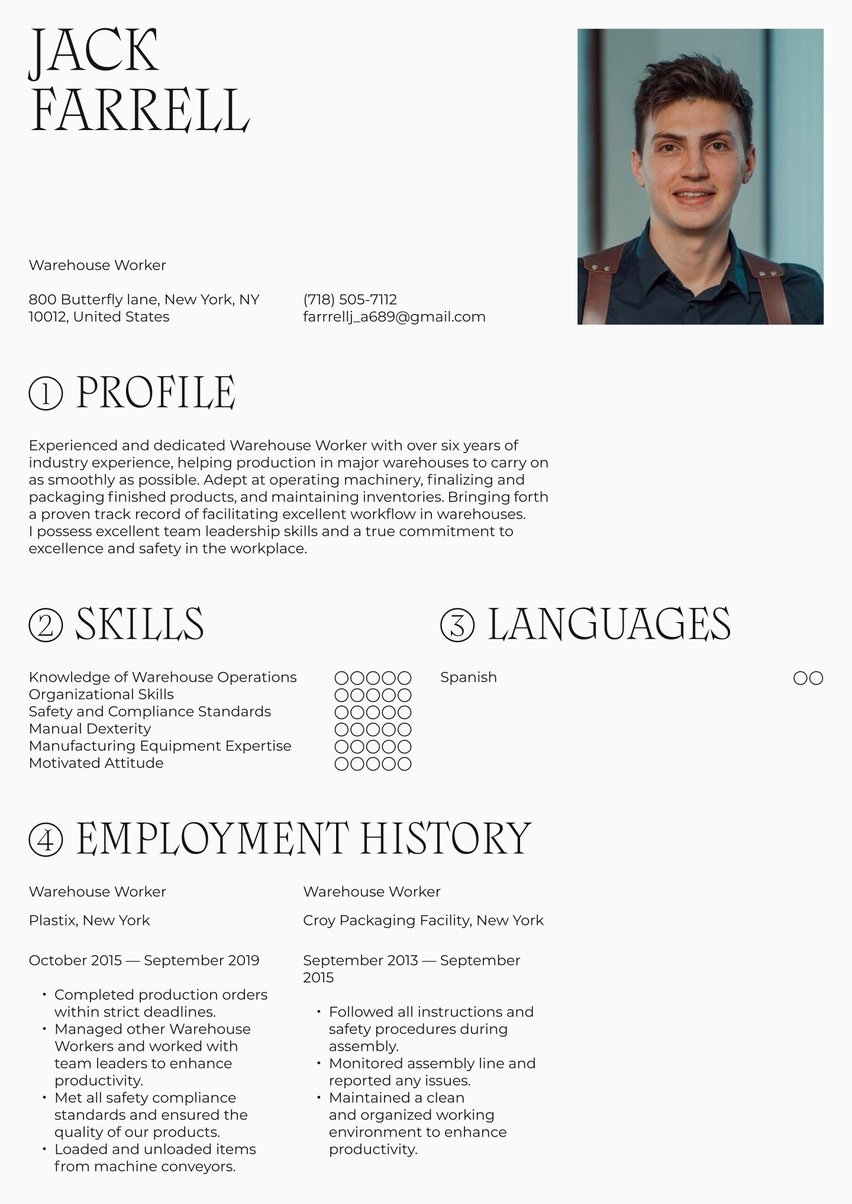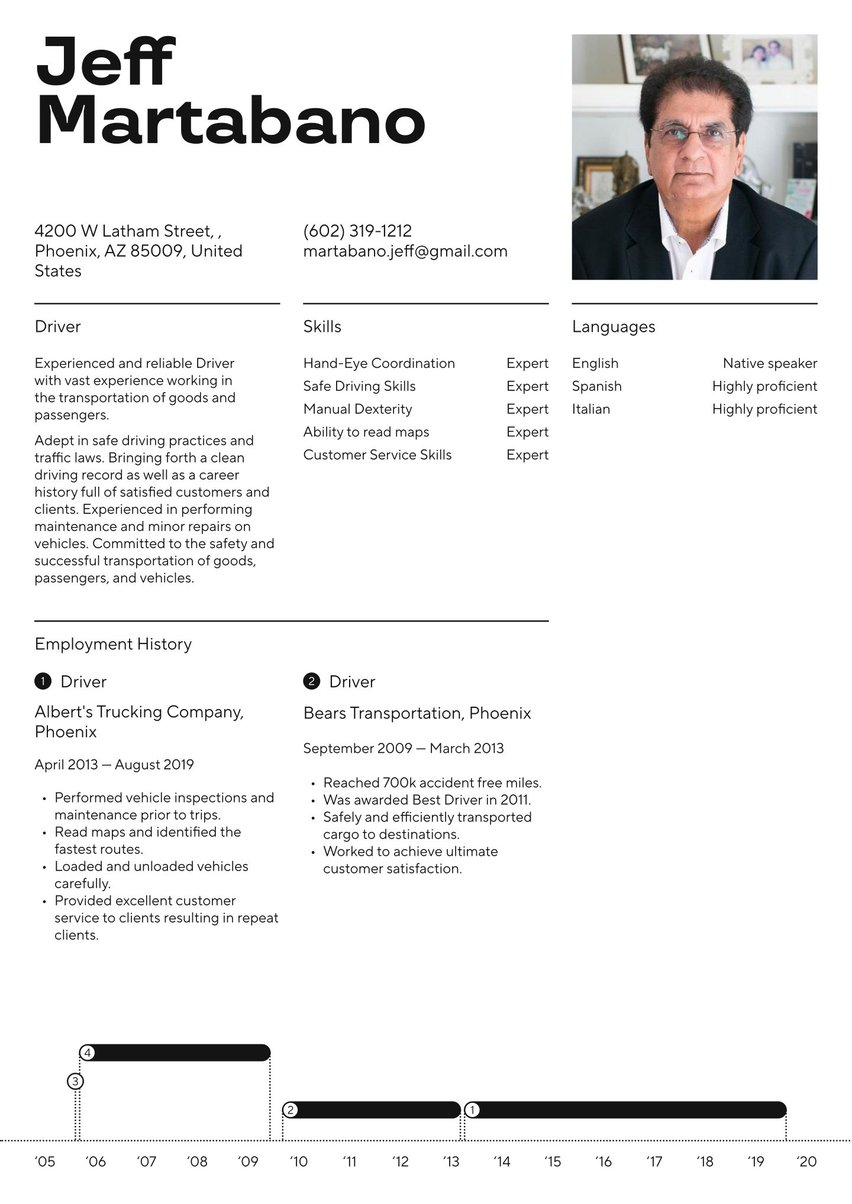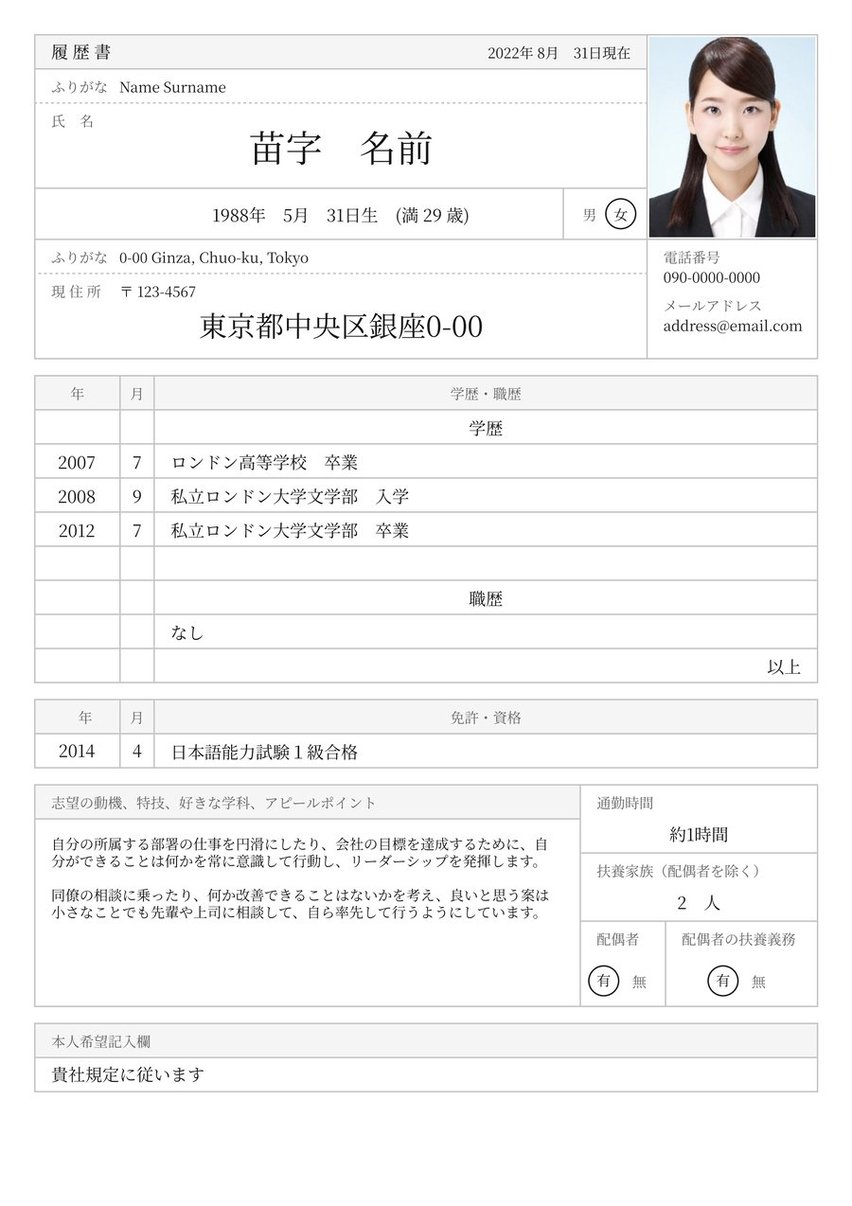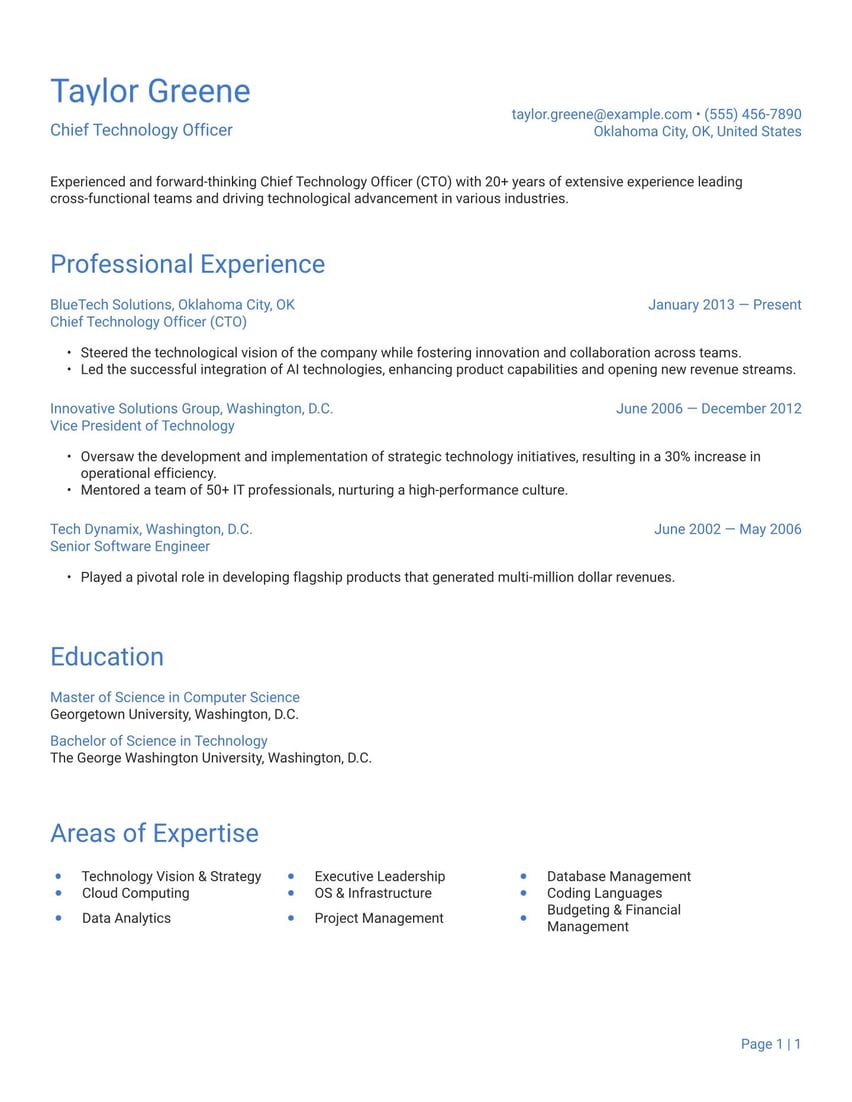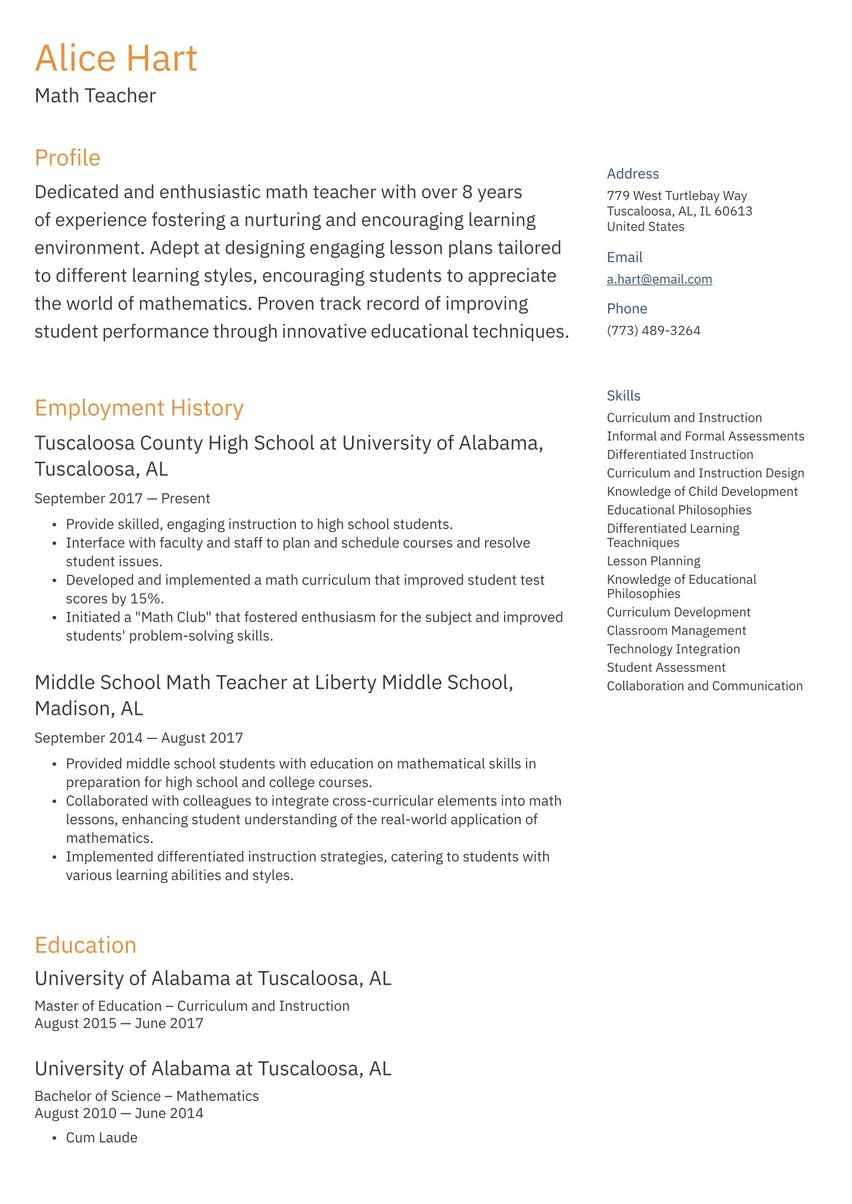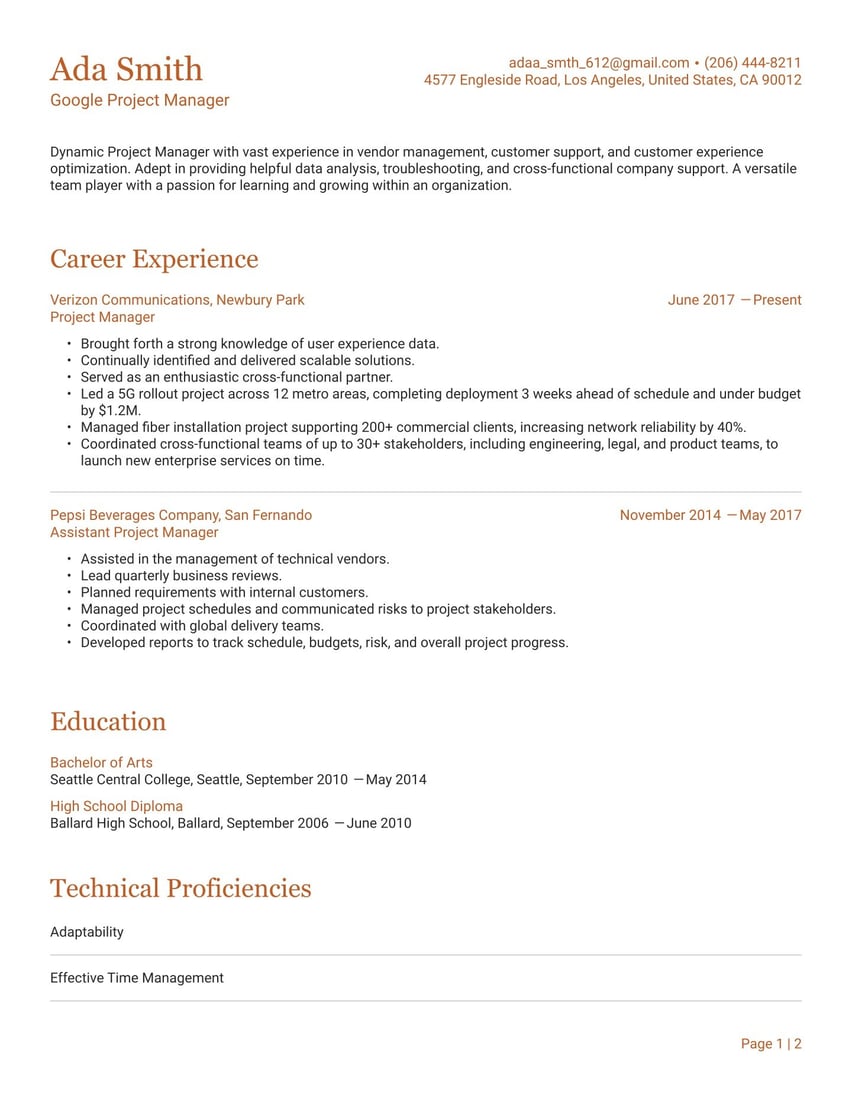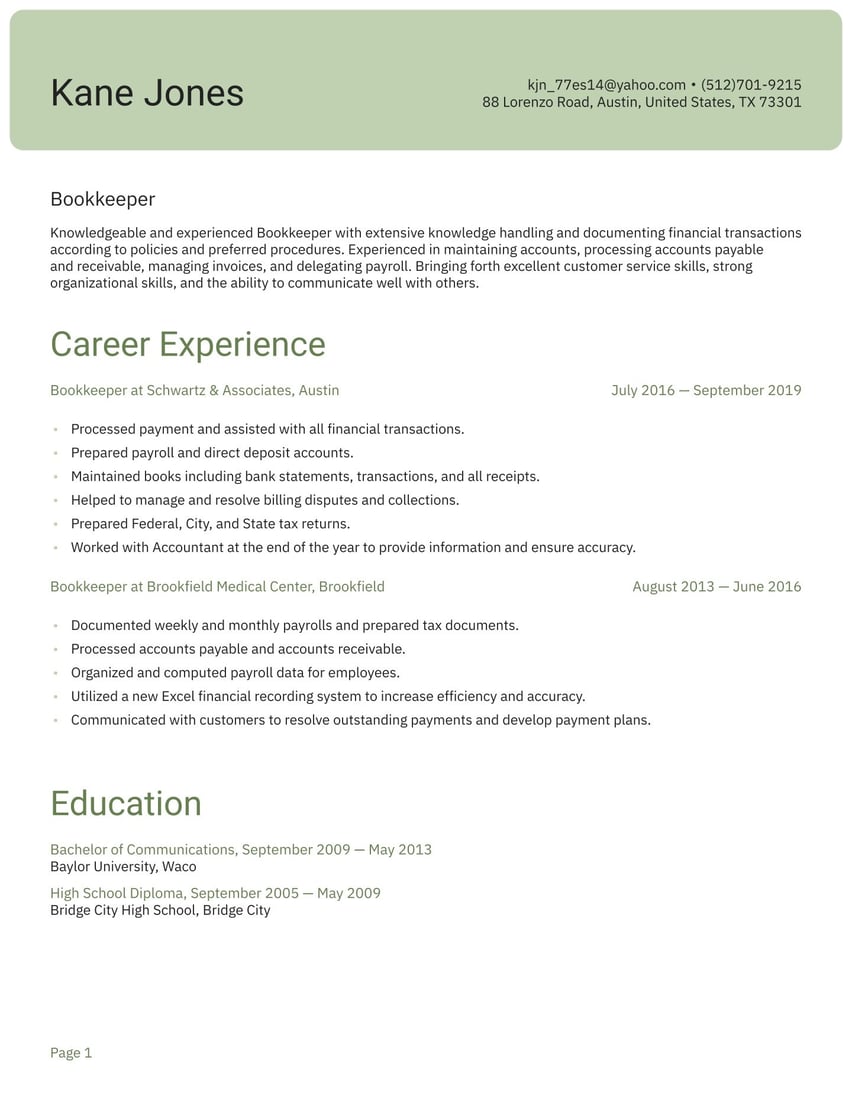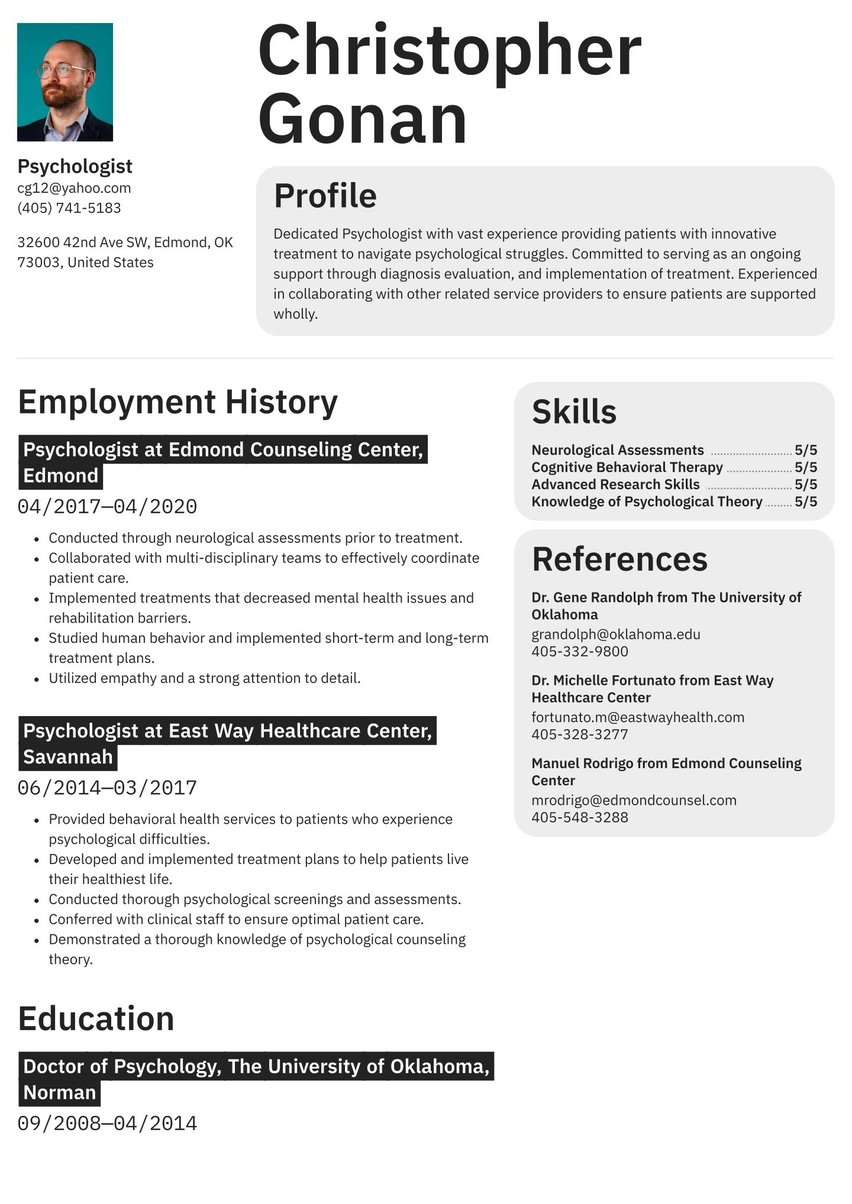Detail-oriented and organized professional with strong understanding of medical terminology and practices. Proven ability to assist healthcare providers with patient examinations and procedures. Expertise in taking vitals, documenting patient information, and ensuring accurate data entry. Strong communicator with patients, families, and healthcare teams. Exceptional multitasker with focus on efficiency and patient care. Proficient in using electronic health records (EHR) and medical software. Committed to providing high-quality and compassionate care to all patients.
06/2018 - present, Certified Nursing Assistant (CNA), Sunrise Senior Living, Denver, CO
- Provide compassionate care to diverse range of residents, assisting with daily living activities and personal hygiene.
- Monitor and record residents' vital signs, dietary intake, and changes in health status.
- Collaborate with healthcare team to develop and implement individualized care plans.
01/2018 - 04/2018, Medical Assistant Externship, Health Medical Center, Denver, CO
- Assisted physicians and nurses with patient care, including taking vital signs, preparing patients for exams, and administering medications.
- Performed routine tests and documented results in electronic health records (EHR).
- Educated patients on treatment plans, medication instructions, and preventive care.
08/2016 - 05/2018, Associate of Applied Science in Medical Assisting, Community College, Denver, CO
- Communication Skills
- Injections
- Medical Terminology
- HIPAA Regulations
- Electronic Health Records
- CPR and First Aid certified
- Infection Control Protocols
- Multidisciplinary Team Collaboration
A medical assistant resume is the lifeblood of your job search. A clear and compelling message will get you to your goal—a great new job—stat! A low-energy, understated resume could leave you in the waiting room. Take charge of your career with a medical assistant resume that gets recruiters’ hearts pumping.
Medical Assistant resume examples by experience level
How can a resume make that much difference? By clearly and dynamically presenting your qualifications and professionalism.
As a healthcare professional, you know that patients, especially ill ones, may make quick judgments on the quality of their care. If that judgment is negative, they may not return. A resume for a medical assistant is like that first visit to a new doctor—the first impression may be the last. Don’t let a great opportunity pass you by. Make the most of every application with a resume that compels HR to take notice.
Resume guide for a medical assistant resume
Fill your prescription for success with Resume.io. Our guides and resume examples cover over 500 professions, and our resume builder makes creating a dynamic resume easier than ever.
This resume guide and corresponding medical assistant resume example will cover the following:
- How to write a medical assistant resume
- Choosing the right resume format for a medical assistant
- How to add your professional contact information
- Using summaries to your advantage
- Adding your medical assistant experience
- Listing education and relevant experience
- Picking the right resume design/layout
- What the medical assistant market looks like and what salary you can expect
How to write a medical assistant resume
Every medical assistant resume sample will be different, as every medical assistant is unique. However, they should all contain certain common elements. Your resume should contain the following sections:
- The resume header
- The resume summary (aka profile or personal statement)
- The employment history section
- The resume skills section
- The education section
Within each section, you are adding evidence of the value you bring to each clinic, hospital or practice in which you have worked. In other words, you are selling yourself to your prospective employer. Just as each resume is different, each healthcare environment is different. To make the best case that you are the right person for the job, you need to know what the employer needs. Do your due diligence to discover the demographics of patients, their needs, what the exact role of the medical assistant is at that workplace and how your skills will fit in. Armed with that information, you can best showcase your value proposition.
The tips below offer a blueprint for focusing the message of your resume.
- Speak directly to each employer by customizing your document. You may need to reorganize the bullet points in your employment history, switch out a skill or rewrite your summary to aim at the qualities within the job description.
- Emphasize achievements rather than responsibilities. Tell what you did, but also the results of your actions. Did you reduce patient wait time? Specialize in calming nervous patients? Increase efficiency in exam room setup? Be as specific as possible, using data when appropriate.
- Be intentional with the design of your resume to project the image of a professional and organized medical assistant.
- Pay attention to keywords within the job ad to increase your chances of overcoming the ATS.
The Applicant Tracking System hurdle
Whenever you apply online, you are inputting your information into an ATS, an application designed to help HR organize and vet resumes. They use keywords and phrases pegged to the job to choose which resumes get seen by a person.
To help you pass this gatekeeper, review the job ad and insert relevant words into your resume. For example, if the job ad says:
“Must haves:
- 1 year of experience urgent care clinic
- Completion of accredited medical assistant program
- Excellent patient communication”
There are several places you can place this information. Your summary could say:
“Medical assistant with one year of urgent care experience post completion of accredited medical assistant program. Excellent communication skills with patients and colleagues, knowledge of sterilization best practices and ability to triage.”
Also include your experience in your work history section, your program completion in your education section, and your patient communication in your skills section.
Choosing the right resume format for a medical assistant
Medical assistants must be organized, neat and efficient. Those traits translate into a resume that contains crisp lines, clear section separations and clarity.
To best show off these attributes in a medical assistant resume with experience, use the reverse chronological order format. Below is an example of this format.
If you are beginning your career, or have made a career change, a functional or hybrid format may work better because either provides the flexibility to focus your resume on transferable skills or education.
Our resume builder offers many choices in different styles, all of which can be personalized. Within these styles, we also have options of all three formats available as resume examples.
Because medical assistants must present a professional and efficient image at all times in their healthcare environment, we recommend choosing one of our professional layouts.
Include your contact information
A header that clearly states your contact information, without including unnecessary details, serves two purposes: 1. to allow HR to reach out without difficulty and 2. to add a design element to your medical assistant resume.
Here are the details you need to include (and how) plus a few to leave out:
- Full name and title. List your first and last name. Use the title of the role you are pursuing.
- Professional email address. Use a clean format like firstname.lastname@gmail.com. Don’t use a quirky, unprofessional email address.
- Phone number. List a number where you can be readily contacted, with a professional voicemail greeting.
- Location. List only your city and state. Don’t list street address or zip code. It’s both outdated and unsafe. Note 'Willing to Relocate' here if applicable.
- LinkedIn. If your LinkedIn profile is active, relevant, and shows your sales network, include it here.
Don’t include:
- Date of birth. Not necessary and could potentially lead to age discrimination.
- Personal details. Marital status, social security number, passport number, etc.
Meredith Qualley
Hospital Medical Assistant
meredith-qualley4@gmail.com
(404) 462-0005
Milwaukee, WI
Meredith Qualley
Medical Assistant extraordinaire
mmmmmmmmSTAT@gmail.com
(404) 462-0005
Milwaukee, WI
Instagram: mmmmmmmmSTAT
Make use of a summary
Do you greet each patient with a personal message such as “Good morning, Ms. Smith? I see you’re here for a physical. Anything in particular we should pay attention to?” This greeting demonstrates that you know your patients and are attentive to their needs.
The 2-3 sentence summary of your resume serves the same purpose. It demonstrates that you are familiar with the healthcare setting and are attentive to the employer’s needs, but it has the added function of highlighting the achievements and attributes that make you an excellent fit for the opening.
Use concise phrases and strong action words such as counseled, treated, assisted, sterilized, prepped or monitored to describe your achievements.
A summary is not a repetition of your work history bullet items in sentence form. Instead, it showcases the very best of your career and illustrates your professional personality. This where you can say that you are detail-oriented and precise, but place emphasis on patient relationships or that you excel at calming nervous children. Don’t neglect administrative tasks like your efficient scheduling or data collection.
Rework your summary for each application
The summary is the perfect spot on your resume to speak directly to each employer. Choose a career accomplishment that best meshes with the skills each one seeks. Without crossing the line to misrepresentation, you may also choose to highlight different aspects of your professional personality to fit the culture and needs of the healthcare setting.
Need inspiration for your summary? Check out our related resumes:
You can find adaptable medical assistant resume examples summary below:
Medical assistant program graduate dedicated to providing quality and comfortable patient care. Proficient in vital sign assessment, specimen collection and assisting with exams. Solid foundation in healthcare best practices and procedures. Excellent communication skills and empathetic nature.
Versatile medical assistant with 5 years of experience in a fast-paced, multi-specialty practice with focus on empathetic treatment of patients. Skilled in clinical procedures such as EKGs, blood draws and injections and administrative tasks. Streamlined patient intake process to reduce appointment times by average of 5 minutes each.
Skilled medical assistant with 10+ years in hospital and clinic settings. Attentive to patients’ emotional states while providing assistance to physicians and nurses. Led team of 10 assistants and trained new employees to ensure compliance with healthcare regulations and protocols. Proficient in EMR management and inventory control.
Outline your medical assistant work experience: the pulse of your career
Using reverse chronological order, list each job, job title, the location and the dates of your tenure in the employment history section of your medical assistant resume. Then, consider what you achieved and your value add to your employer in each position.
Your goal is to build a story of career success through bullet items that show off your successes and how they improved medical care or saved time or money for the practice. Begin each item with a strong action you took and follow it with your results. Get specific and use data and details wherever possible.
Listing job duties will make your resume sound like a generic job description. A resume needs to distinguish you from the crowd. These basic bullet items are a mere list of tasks:
- Collected patient data
- Took vital signs
- Assisted doctors with exams
Can you tell anything about the medical assistant who wrote that job description? A dynamic work history section goes far beyond listing responsibilities to enticing HR by showing how you use your skills to improve the practice and patient satisfaction.
Here are improved versions that still include the tasks performed:
- Developed online patient data and achieved 90% compliance, reducing crowding in waiting room and time before patient saw doctor by average of 6 minutes.
- Collected, recording and evaluated vital signs including blood pressure, temperature, pulse, and respiratory rate of average of 40 patients per day.
- Prepared exam rooms, provided necessary equipment and assisted patients in positioning and comfort.
Use the STAR method as a framework
When writing your employment successes, you may start off with the situation you faced, tell what your task was and the action you took. Follow that up with your results. If relevant, you may add a reflection.
Take a look at the medical assistant employment history resume sample below:
Certified Nursing Assistant (CNA) at Sunrise Senior Living, Denver, CO
June 2018 - Present
- Provide compassionate care to diverse range of residents, assisting with daily living activities and personal hygiene.
- Monitor and record residents' vital signs, dietary intake, and changes in health status.
- Collaborate with healthcare team to develop and implement individualized care plans.
Medical Assistant Externship at Health Medical Center, Denver, CO
January 2018 - April 2018
- Assisted physicians and nurses with patient care, including taking vital signs, preparing patients for exams, and administering medications.
- Performed routine tests and documented results in electronic health records (EHR).
- Educated patients on treatment plans, medication instructions, and preventive care.
How to write a medical assistant resume with no experience
The keys to developing a resume with no medical assistant experience lie in your transferable skills, or the skills that you have demonstrated in other jobs or positions of responsibility that apply to working in a healthcare setting.
Have you always been interested in helping others? Perhaps you babysat or helped an older neighbor with chores or shopping. That makes you empathetic, caring and communicative. If you worked an afterschool job at a fast food restaurant, you have demonstrated responsibility, ability to follow procedure and health and safety standards and time management.
Use your summary to focus on why you want to begin your career in medical assisting and the skills you learned in your certification program. Include any jobs with transferable skills in your employment history section, but consider using a functional or hybrid format to play up your education.
Include the relevant key skills that make you a great medical assistant
At first glance, the skills section seems like an easy one to put together, but it needs to be well thought out because it tells recruiters if you have what they are looking for and what you think are the most important attributes for the job.
The best medical assistant resume skills lists blend hard and soft skills to develop a complete picture of your professional abilities as well as demeanor. Hard skills, the technical proficiencies necessary to perform your duties, may include: CPR, phlebotomy, vital sign assessment, safety and privacy regulations, knowledge of anatomy and electronic medical records systems
Patients and medical staff may be more concerned with your soft skills. Empathy, communication, customer service, teamwork, adaptability and stress management are the soft skills that will make you a welcome face around any healthcare establishment.
To guide you in curating this section, our resume builder suggests pre-written key skills to choose from. You may also set the proficiency range for each. This section is also fully customizable.
Here’s what the skills box looks like in our medical assistant resume template.
Key Skills and Proficiencies
Saying you are an excellent communicator is a start, but provide examples of your skills throughout your resume. For example:
- Active listening by describing a time you helped a patient by paying careful attention to their description of their pain
- Problem-solving by telling how you resolved a scheduling error that caused a doctor to be overbooked
- Attention to safety procedures by detailing how you sterilize and clean an exam room.
The best method of discovering what your prospective employer values is to review the job description with care.
Detail your education & relevant medical assistant certifications
Medical assistants need a high school diploma or its equivalent and completion of a post-graduate medical assistant program, most of which take six months to a year. The education section of a resume for a medical assistant lists these accomplishments in reverse chronological order.
If you have been on the job for a few years, you may have other accomplishments that may be listed here. They include:
- Training and certification. Certification in any medical procedures, advanced training, courses or workshops.
- Ongoing education. If you are working toward an associate’s or bachelor’s degree in a medical subject, add your program and expected date of graduation.
- Professional development. Any professional organizations or seminars that advance your medical knowledge or administrative abilities.
For entry-level workers, consider giving more weight to your skills and education by moving your employment history section down the page.
Associate of Applied Science in Medical Assisting, Community College, Denver, CO
August 2016 - May 2018
Pick the right resume layout and design for a medical assistant resume
Your scrubs are always crisp and clean, your personal appearance neat and you greet patients with a smile. The exam rooms sparkle and every instrument is in its place. You project an image of professionalism, friendliness and organization.
The design of your resume needs to do the same. Remember that first impression counts, so you want the hiring manager to take notice because your sleek, easy-to-read resume reflects the qualities they seek in a medical assistant.
Unless you are applying to work in a pediatric practice, avoid any images and bright colors. Color is unnecessary, but if you choose to use it, stick with a muted tone.
A medical assistant resume should stick to the basics to avoid any hint of clutter or fuss. Choose a modern, easy-to-read font for your text with an opposing, bold font for section titles. Your name should be the most noticeable text on the page. We suggest one of or many simple layouts from among the field-tested resume templates we offer.
These templates take your focus off formatting and other technical details so you can hone in on your content and get your resume out there faster.
Medical assistant text-only resume example
Profile
Detail-oriented and organized professional with strong understanding of medical terminology and practices. Proven ability to assist healthcare providers with patient examinations and procedures. Expertise in taking vitals, documenting patient information, and ensuring accurate data entry. Strong communicator with patients, families, and healthcare teams. Exceptional multitasker with focus on efficiency and patient care. Proficient in using electronic health records (EHR) and medical software. Committed to providing high-quality and compassionate care to all patients.
Employment history
Certified Nursing Assistant (CNA) at Sunrise Senior Living, Denver, CO
June 2018 - Present
- Provide compassionate care to diverse range of residents, assisting with daily living activities and personal hygiene.
- Monitor and record residents' vital signs, dietary intake, and changes in health status.
- Collaborate with healthcare team to develop and implement individualized care plans.
Medical Assistant Externship at Health Medical Center, Denver, CO
January 2018 - April 2018
- Assisted physicians and nurses with patient care, including taking vital signs, preparing patients for exams, and administering medications.
- Performed routine tests and documented results in electronic health records (EHR).
- Educated patients on treatment plans, medication instructions, and preventive care.
Skills
- Communication Skills
- Injections
- Medical Terminology
- HIPAA Regulations
- Electronic Health Records
- CPR and First Aid certified
- Infection Control Protocols
- Multidisciplinary Team Collaboration
Education
Associate of Applied Science in Medical Assisting, Community College, Denver, CO
August 2016 - May 2018
Medical assistant job market and outlook
The aging population continues to fuel rapid growth in the healthcare industry and that includes medical assistants. Healthcare hiring hit a 30-year peak in 2023. That means more new opportunities for trained workers.
- About 105,900 new jobs for medical assistants are projected over the next decade.
- LinkedIn listed more than 17,000 medical assistant jobs in March 2024.
- Physicians are the largest employers of medical assistants.
What type of salary you can expect as a medical assistant
Medical assistants earn a median salary of $38,270. Those working in outpatient care centers earned $42,820; those in hospitals earned $40,060; physicians’ offices, $37,970; and other health practitioners, $35,070.
Key takeaways for building a medical assistant resume
Medical assistants perform valuable functions in all healthcare settings To make the most of your training, your resume needs to project an image of competence, organization and empathy along with detailing your medical and administrative knowledge. Customize each application to highlight the skills and traits that best suit each job description.
Our online resume builder will help you step into the market faster so you can land your next great job.


.jpg)

.jpg)





















